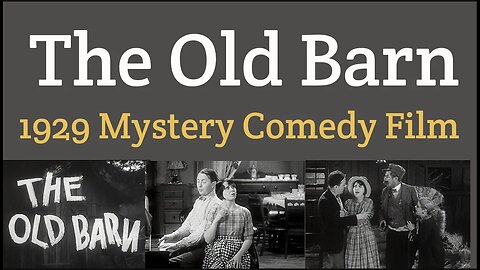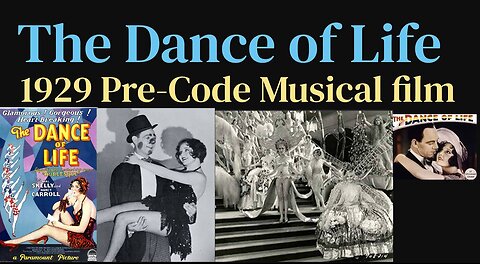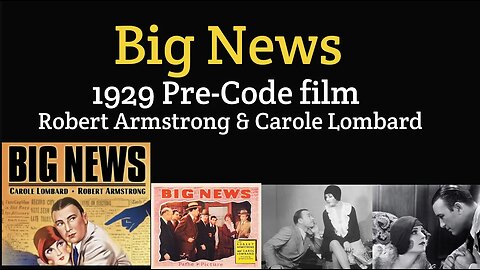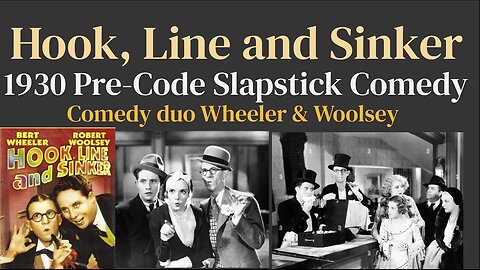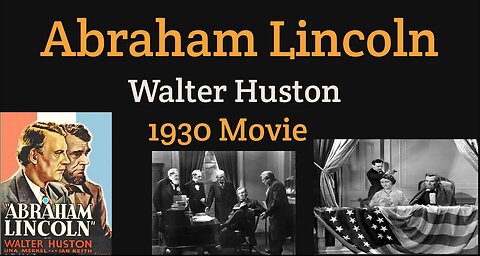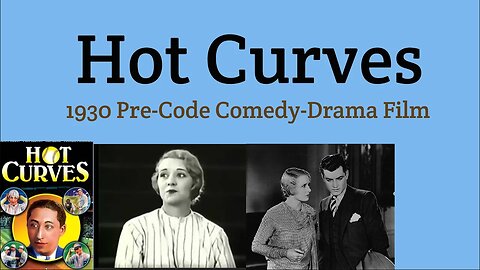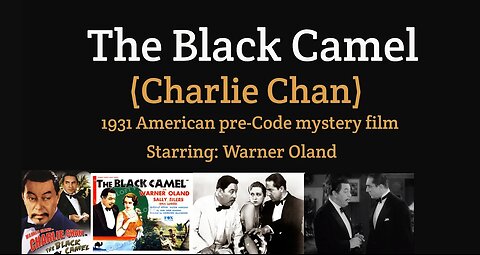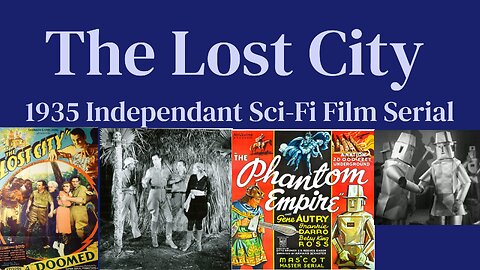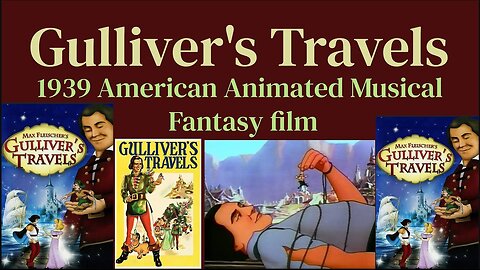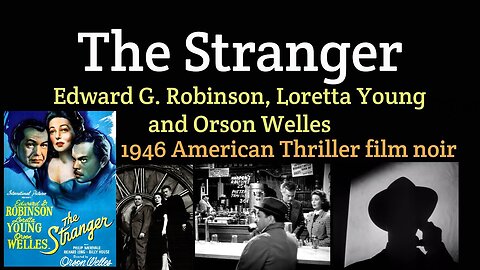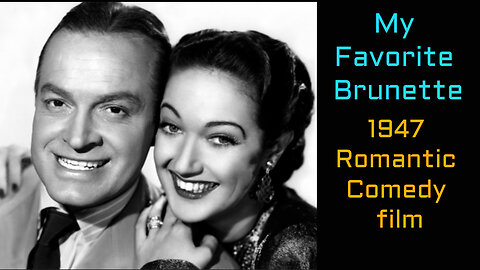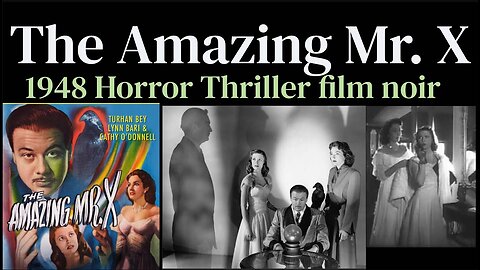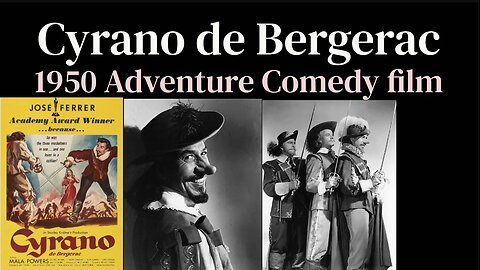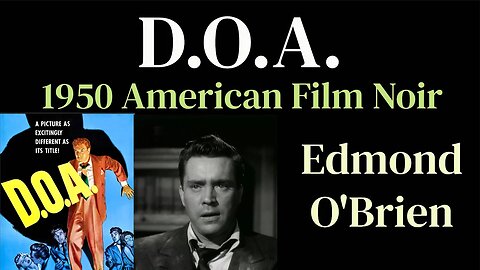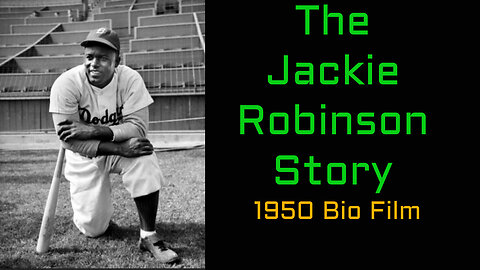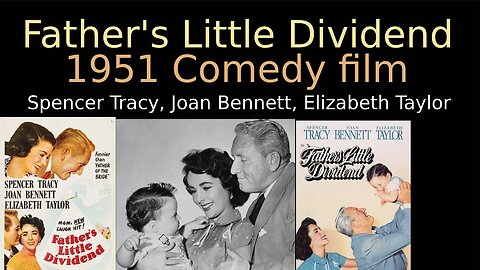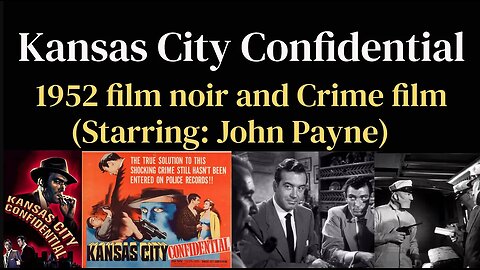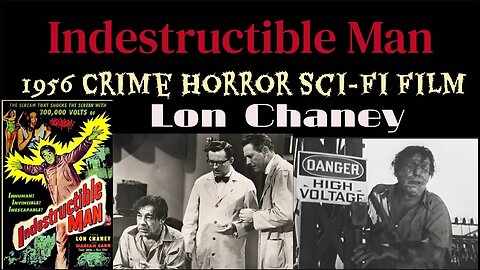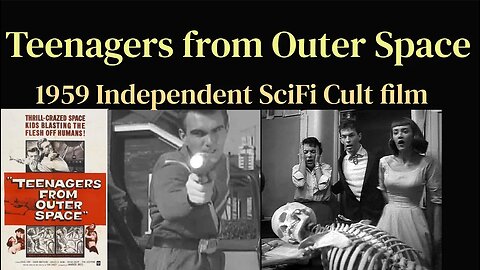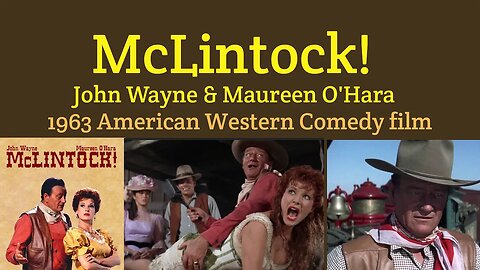Premium Only Content
This video is only available to Rumble Premium subscribers. Subscribe to
enjoy exclusive content and ad-free viewing.
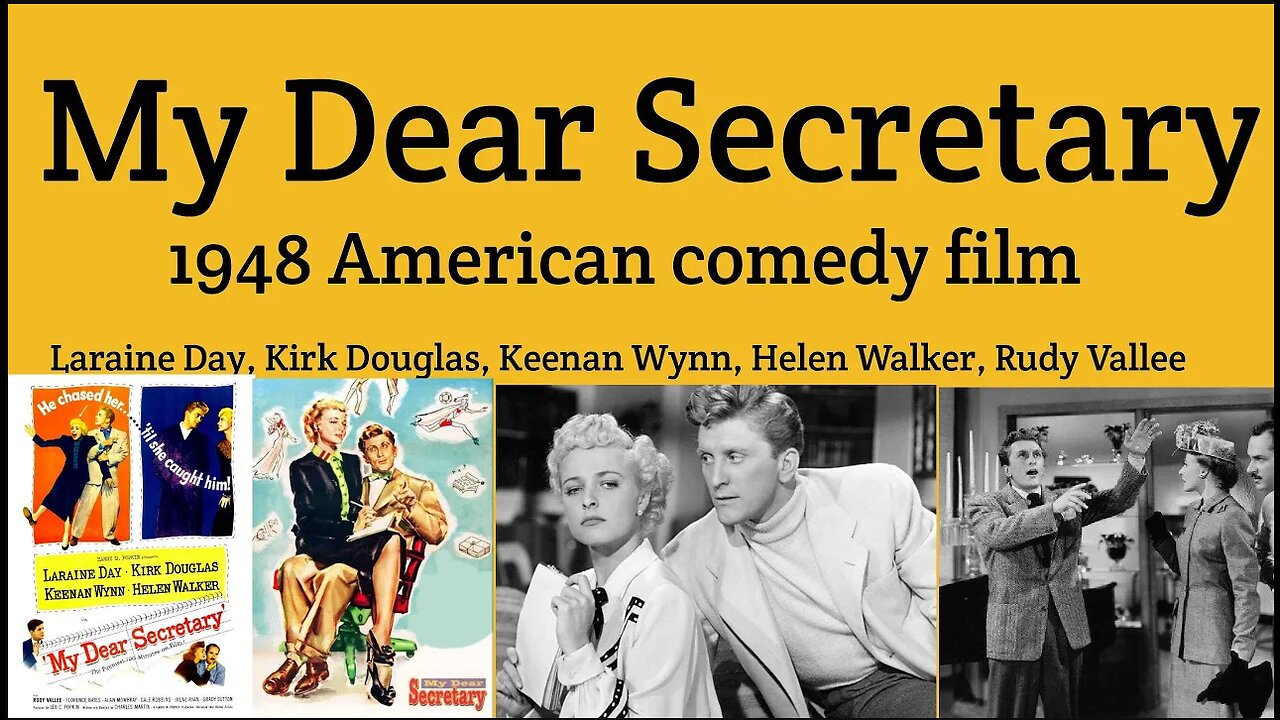
Movies
TeslaWirelessRadio
- 33 / 51
1
The Inspector General (1949 Color Musical Comedy film)
TeslaWirelessRadio
The Inspector General is a 1949 American Technicolor musical comedy film, suggested by the play by Nikolai Gogol. It stars Danny Kaye and was directed by Henry Koster. The film also stars Walter Slezak, Barbara Bates, and Elsa Lanchester. Original music and lyrics are by the associate producer Sylvia Fine, who was married to Danny Kaye, with Johnny Green credited for musical direction and incidental score.
Premise
The film is loosely based on Nikolai Gogol's play The Inspector General. The plot is re-located from the Russian Empire into an unspecified corrupted region of a country that suddenly finds itself under the supervision of the First French Empire.
Plot
Georgi (Danny Kaye), an illiterate member of a wandering band of Gypsies led by Yakov (Walter Slezak) escapes from a travelling medicine show after he innocently let's slip that the elixir they're selling is a fraud. Tired and hungry, he wanders into the small town of Brodny and whilst trying to sample the contents of a horse's feedbag, he's arrested as a vagrant and sentenced to hang the next day by a corrupt police chief (Alan Hale), desperate to prove his efficiency.
The town is run by a corrupt Mayor (Gene Lockhart), whose employees and councillors are all his cousins and equally corrupt and incompetent, but they are frightened when they learn that the Inspector General is in their neighborhood, and probably in disguise. The band of officials and the mayor want to protect their town and their lives, so, acting foolishly they seal off every road to keep the inspector from entering their town. They mistake Georgi for the Inspector and ply him with food and drink whilst plotting to have him killed. Yakov wanders into the small town and convinces Georgi to stay on as an inspector general and accept the bribes the officials so willingly throw at him. Of course, Yakov wants to seize Georgi's misfortune and turn it into a new start for his own life.
Cast
Danny Kaye as Georgi
Walter Slezak as Yakov
Barbara Bates as Leza
Elsa Lanchester as Maria
Gene Lockhart as The Mayor
Alan Hale as Kovatch
Walter Catlett as Colonel Castine
Rhys Williams as Inspector General
2
Glorifying the American Girl (1929 Pre-Code Musical Comedy film)
TeslaWirelessRadio
Glorifying the American Girl is a 1929 American Pre-Code musical comedy film produced by Florenz Ziegfeld that highlights Ziegfeld Follies performers. The last third of the film, which was filmed in early Technicolor, is basically a Follies production, with appearances by Rudy Vallee, Helen Morgan, and Eddie Cantor.
Rex Beach was paid $35,000 for the original story.
The script for the film was written by J.P. McEvoy and Millard Webb and directed by John W. Harkrider and Millard Webb. The songs were written by Irving Berlin, Walter Donaldson, Rudolf Friml, James E. Hanley, Larry Spier and Dave Stamper.
Plot
The plot involves a young woman (Mary Eaton) who wants to be in the Follies, but in the meantime is making ends meet by working at a department store's sheet music department, where she sings the latest hits. She is accompanied on piano by her childhood boyfriend (Edward Crandall), who is in love with her, despite her single-minded interest in her career. When a vaudeville performer (Dan Healy) asks her to join him as his new partner, she sees it as an opportunity to make her dream come true. Upon arriving in New York City, our heroine finds out that her new partner is only interested in sleeping with her and makes this a condition of making her a star. Soon, however, she is discovered by a representative of Ziegfeld.
Cast
Mary Eaton as Gloria Hughes
Dan Healy as Danny Miller
Kaye Renard as Mooney
Edward Crandall as Buddy Moore
Gloria Shea as Barbara (billed as Olive Shea)
Sarah Edwards as Mrs. Hughes
Lou Hearn as tailor shop customer
Cameo appearances
Noah Beery
Irving Berlin
Norman Brokenshire
Billie Burke
Eddie Cantor
Desha Delteil
Charles B. Dillingham
Texas Guinan
Otto Kahn
Nancy Kelly
Ring Lardner
Bull Montana
Helen Morgan
Tony Sansone
Louis Sorin
Rudy Vallee
Jimmy Walker
Johnny Weissmuller
Joseph Urban
Florenz Ziegfeld Jr.
Adolph Zukor
Production
This Pre-Code movie is notable for being the first talkie to use the word "damn" (that credit usually goes to either Pygmalion or Gone with the Wind). The word is used twice by Sarah Edwards as well as multiple times in the skit involving Eddie Cantor, Louis Sorin and Lew Hearn. (The word was also used twice in the film Coquette, released in April of the same year.)
The revue sequence contains virtual nudity and revealing costumes.
3
The Old Barn (1929 Talkie Film)
TeslaWirelessRadio
Plot
A motley collection of guests and regulars at a country hotel are anxious one dark and stormy night when they hear by a radio news bulletin that a dangerous criminal has just broke jail and is headed their way. A surly mystery man answering the description shows up, and then hides out in a nearby barn.
Cast
Johnny Burke
Thelma Hill
Daphne Pollard
Andy Clyde
Irving Bacon
Vernon Dent
Dave Morris
Ruth Kane
4
The Dance of Life (1929 American Pre-Code Musical film)
TeslaWirelessRadio
The Dance of Life is a 1929 American Pre-Code musical film. It is the first of three film adaptations of the popular 1927 Broadway play Burlesque, with the others being Swing High, Swing Low (1937) and When My Baby Smiles at Me (1948). The film was directed by John Cromwell (who also appeared in the film with a small part) and A. Edward Sutherland.[2] Hal Skelly appeared in the lead role as Ralph “Skid” Johnson after playing the same role in the Broadway version at the Plymouth Theater. He took part in the production for fifty-two weeks before leaving his role to take part in the film.[3] Charles D. Brown, Ralph Theodore and Oscar Levant also appeared in the Broadway production.
The Dance of Life was shot at Paramount's Astoria Studios in Astoria, Queens, and included Technicolor sequences, directed by John Cromwell and A. Edward Sutherland.
Plot
Burlesque comic Ralph "Skid" Johnson, and specialty dancer Bonny Lee King, end up together on a cold, rainy night at a train station, after she fails an audition with a vaudeville company and he complains about her treatment by the impresario of the show and is fired. They decide to team up and apply for work with a much better show on "the big wheel" called the High Steppers Burlesque Company in Milwaukee, Wisconsin, run by Lefty Miller.[4]
Miller hires the duo and the two fall in love. Later Skid asks her to marry him, but he gets drunk and ruins their wedding night. During this time a female comic, Sylvia Marco, who is attracted to Skid, tries to come between them.
Cast
Hal Skelly as "Skid" Johnson
Nancy Carroll as Bonny King
Dorothy Revier as Sylvia Marco
Ralph Theodore as Harvey Howell
Charles D. Brown as Lefty
Al St. John as Bozo
May Boley as Gussie
Oscar Levant as Jerry
Marjorie Kane (uncredited)
John Cromwell as Speakeasy Doorkeeper
Soundtrack
"True Blue Lou"
Music by Richard A. Whiting
Lyrics by Sam Coslow and Leo Robin
Sung by Hal Skelly
"The Flippity Flop"
Music by Richard A. Whiting
Lyrics by Sam Coslow and Leo Robin
"King of Jazzmania"
Music by Richard A. Whiting
Lyrics by Sam Coslow and Leo Robin
"Ladies of the Dance"
Music by Richard A. Whiting
Lyrics by Sam Coslow and Leo Robin
"Cuddlesome Baby"
Music by Richard A. Whiting
Lyrics by Sam Coslow and Leo Robin
"Mightiest Matador"
Music by Richard A. Whiting
Lyrics by Sam Coslow and Leo Robin
"Sweet Rosie O'Grady"
Written by Maude Nugent
"In the Gloaming"
Music by Annie Fortescue Harrison
Lyrics by Meta Orred
"Sam, the Old Accordion Man"
Written by Walter Donaldson
5
Big News (1929 American Pre-Code film)
TeslaWirelessRadio
Big News is a 1929 American Pre-Code film directed by Gregory La Cava, released by Pathé Exchange, and starring Robert Armstrong and Carole Lombard, billed as "Carol Lombard".
Cast
Robert Armstrong as Steve Banks
Carole Lombard as Margaret Banks (billed as Carol Lombard)
Louis Payne as Hensel
Wade Boteler as O'Neill
Charles Sellon as Addison
Sam Hardy as Reno
Tom Kennedy as Officer Ryan
Warner Richmond as District Attorney Phelps
Helen Ainsworth as Vera, society editor
James Donlan as Deke
George "Gabby" Hayes as Hoffman, reporter
Vernon Steele as reporter
Clarence Wilson as Coroner
Colin Chase as Birn
Robert Dudley as Telegraph editor
Plot
Steve Banks (Armstrong) is a hard-drinking newspaper reporter. His wife Margaret (Lombard), a reporter for a rival paper, threatens to divorce him if he doesn't quit the drinking that is compromising his career. Steve pursues a story about drug dealers even when his editor fires him. When the editor is murdered, Steve is accused of the killing.
Preservation status
The film exists in a 16mm reduction print
6
The Bees' Buzz (1929 "Talkie" Comedy film)
TeslaWirelessRadio
The Bees' Buzz is a 1929 American film directed by Mack Sennett.
Plot
Andy and Harry get into trouble while trying to stop the marriage of Andy's daughter.
Cast
Harry Gribbon as Homer Ashcraft
Andy Clyde as Peggy's father
Barbara Leonard as Peggy
Tyler Brooke as Peggy's suitor
Vernon Dent as Jim
Ruth Kane as A party guest
Billy Gilbert
7
Hook, Line and Sinker (1930 Pre-Code Slapstick Comedy film)
TeslaWirelessRadio
Directed by Edward F. Cline from a screenplay by Ralph Spence and Tim Whelan. It was the third starring vehicle for the comedy team of Wheeler & Woolsey (Bert Wheeler and Robert Woolsey), and also featured Dorothy Lee. It would be one of the largest financial successes for RKO Pictures in 1930.
Plot
Two fast-talking insurance salesmen — Wilbur Boswell and J. Addington Ganzy — help penniless socialite Mary Marsh to turn a dilapidated hotel, which was willed to her, into a thriving success. They soon run into trouble, however, in the form of two sets of rival gangsters who want to break into the hotel safe; also, Mary's mother, Rebecca Marsh, wants her to marry wealthy lawyer John Blackwell, although Mary has fallen in love with Wilbur.
Cast
Bert Wheeler as Wilbur Boswell
Robert Woolsey as Addington Ganzy
Dorothy Lee as Mary Marsh
Jobyna Howland as Rebecca Marsh
Ralf Harolde as John Blackwell (Buffalo Blackie)
William B. Davidson as Frank Dukette (Duke of Winchester)
Natalie Moorhead as Duchess Bessie Von Essie
George F. Marion as Ritz De La Rivera Bellboy
Hugh Herbert as Hotel House Detective
Stanley Fields as McKay
Reception
The film made a profit of $225,000, and would be one of the top two money earners for RKO Radio Pictures in 1930.
8
Abraham Lincoln (1930) Pre-Code Biographical film
TeslaWirelessRadio
Abraham Lincoln, also released under the title D. W. Griffith's "Abraham Lincoln", is a 1930 pre-Code American biographical film about Abraham Lincoln directed by D. W. Griffith. It stars Walter Huston as Lincoln and Una Merkel, in her second speaking role, as Ann Rutledge.
The script was co-written by Stephen Vincent Benét, author of the Civil War prose poem John Brown's Body (1928), and Gerrit Lloyd. This was the first of only two sound films made by Griffith.
Plot summary
The first act of the film covers Lincoln's early life as a storekeeper and rail-splitter in New Salem and his early romance with Ann Rutledge, and his early years as a lawyer and his courtship and marriage to Mary Todd in Springfield, Illinois. The majority of the film deals with Lincoln's presidency during the American Civil War and culminates with Lee's surrender and Lincoln's assassination at Ford's Theatre.
Cast
Walter Huston as Abraham Lincoln
Una Merkel as Ann Rutledge
Characters in the order of their appearance
W. L. Thorne as Tom Lincoln
Lucille La Verne as Mid-Wife
Helen Freeman as Nancy Hanks Lincoln
Otto Hoffman as Offut
Walter Huston as Abraham Lincoln
Edgar Deering as Armstrong
Una Merkel as Ann Rutledge
Russell Simpson as Lincoln's Employer
Charles Crockett as Sheriff
Kay Hammond as Mary Todd Lincoln
Helen Ware as Mrs. Edwards
E. Alyn Warren as Stephen A. Douglas
Jason Robards as Herndon
Gordon Thorpe as Tad Lincoln
Ian Keith as John Wilkes Booth
Cameron Prudhomme as John Hay (secretary to the president)
James Bradbury, Sr. as General Scott
Jimmie Eagle as Young Soldier
E. Alyn Warren as General Grant
Oscar Apfel as Secretary of War Stanton
Frank Campeau as General Sheridan
Hobart Bosworth as General Lee
Henry B. Walthall as Colonel Marshall
Reception
The film received positive reviews from contemporary critics. Mordaunt Hall of The New York Times called it "quite a worthy pictorial offering with a genuinely fine and inspiring performance by Walter Huston in the role of the martyred President"[3] and later put it on his year-end list of the ten best films of 1930.
Historical accuracy
The film covers some little-known aspects of Lincoln's early life, such as his romance with Ann Rutledge, his depression and feared suicidal tendencies after her death, and his unexplained breaking off of his engagement with Mary Todd. However, the film surmises that was because of unresolved feelings over Ann Rutledge, and it adds a dramatic scene in which Lincoln stands Mary up on their scheduled wedding day. In reality, Lincoln broke off the engagement but before the wedding day. He would later regret his decision, return to ask Mary's hand in marriage once again, and follow through this time, as happens in the film.
While the early scenes of Lincoln's life are remarkably accurate, many of the later scenes contain historical inaccuracies. The Lincoln-Douglas debates, in addition to the historically-accurate topic of the extension of slavery, are turned into an argument about secession. Lincoln was an underdog for the Republican Presidential nomination in 1860 although the film suggests that he was the sole nominee as a result of the Lincoln-Douglas debates.
The outbreak of the Civil War seems to be the Union firing on Charleston, South Carolina from Fort Sumter, rather than the other way around. Also, early in hostilities, General Winfield Scott is depicted as being overconfident of a quick victory and something of a buffoon, but in reality, he was one of the voices in the minority claiming the war would be long, costly, and bloody.
In the film, Lincoln receives a report from the Secret Service that some Copperheads in the North have issued threats against him. However, in reality, the Secret Service was not created until two months after Lincoln's death.
Finally, in the film's climax, Lincoln delivers a conflation of the words of the Gettysburg Address and Second Inaugural Address at Ford's Theatre on April 14, 1865, just moments before his assassination. That was Griffith's second portrayal of Lincoln's assassination, the first being in The Birth of a Nation.
9
Hot Curves (1930 Pre-Code) Comedy Drama film
TeslaWirelessRadio
Hot Curves is a 1930 American Pre-Code comedy-drama film produced and distributed by Tiffany Pictures and directed by Norman Taurog. A print is held by the Library of Congress.
Rex Lease, Benny Rubin and Alice Day star.
The supporting cast features Pert Kelton.
Plot
Jim Dolan, with a little help from his grandmother, shows the Pittsburgh baseball team what a good pitcher he can be. Jim also becomes involved in romance with Elaine, the manager's daughter, while Maizie, a gold digger, schemes to come between them.
Ballpark vendor Benny, by coincidence, becomes the team's catcher while his quirky sweetheart, Cookie, cheers him on. Jim becomes arrogant, alienates teammates and is even suspended, but snaps out of it in time to save the big game of the World Series.
Cast
Benny Rubin - Benny Goldberg
Rex Lease - Jim Dolan
Alice Day - Elaine McGrew
Pert Kelton - Cookie
John Ince - Mr McGrew, Baseball Team Manager, Elaine's father
Mary Carr - "Grandma Dolan"
Mike Donlin - Baseball Team Scout
Natalie Moorhead - Maizie
Paul Hurst - "Slug" (a baseball player)
Henry Hall - Baseball Team Owner
Marceline Day - Girl
Robert Livingston - a baseball player (billed as Robert Randall)
Greta Granstedt - Girl
10
Half Shot at Sunrise (1930 Pre-Code Comedy film)
TeslaWirelessRadio
Half Shot at Sunrise is a 1930 American Pre-Code comedy film starring the comedy duo Wheeler & Woolsey and Dorothy Lee. Their fourth film together, it was the second starring vehicle for the two, following the success of The Cuckoos, which had been released earlier in 1930. Directed by Paul Sloane, from a screenplay by Anne Caldwell, James Ashmore Creelman, Ralph Spence, and Fatty Arbuckle, which had been tailored to highlight the comedic talents of Wheeler and Woolsey.
Plot
During World War I, two American Doughboys, Tommy Turner and Gilbert Simpson, are more interested in picking up girls than in military duty. In Paris, they go AWOL in order to follow their libertine pursuits. They alternate between impersonating officers in order to impress the ladies, and avoiding being found out by the military police. During their hijinks, the pair accidentally steal the car of Colonel Marshall (their commanding officer), which is how Tommy meets and falls in love with Annette, who unbeknownst to him is Colonel Marshall's younger daughter.
Cast
Bert Wheeler as Tommy Turner
Robert Woolsey as Gilbert Simpson
Dorothy Lee as Annette Marshall
Hugh Trevor as Lieutenant Jim Reed
Edna May Oliver as Mrs. Marshall
Eddie De Lange as MP
E. H. Calvert as General Hale
Alan Roscoe as Captain Jones
John Rutherford as MP Sergeant
George MacFarlane as Colonel Marshall
Roberta Robinson as Eileen Marshall
Leni Stengel as Olga
11
The Bat Whispers (1930 American Pre-Code mystery film) (widescreen)
TeslaWirelessRadio
The Bat Whispers is a 1930 American Pre-Code mystery film directed by Roland West, produced by Joseph M. Schenck, and released by United Artists.
The film is based on the 1920 mystery play The Bat, written by Mary Roberts Rinehart and Avery Hopwood, and is the second film version by the same director, previously adapted in 1926. An early talkie and one of the first widescreen films, West financed the cinematography, which required two cameramen and several techniques.
It was considered a lost film for many years but was restored from duplicate filmstock in 1988.
Plot
A mysterious criminal by the name of "The Bat" eludes police and then finally announces his retirement to the country.
In the countryside near the town of Oakdale, news of a bank robbery in Oakdale has put Mrs. Van Gordner's maid, Lizzie, on edge. Van Gordner is leasing the house from Mr. Fleming, the Oakdale bank president, who is in Europe.
The chief suspect in the bank robbery, a cashier, has disappeared. Van Gordner's niece, Dale arrives followed by the gardener she has hired. Dr. Venrees arrives and tells Van Gordner that he has received a telegram from Fleming stating that because of the robbery he will be returning soon and will need to occupy his house.
12
The Royal Bed (1931 Pre-Code Satirical Comedy film)
TeslaWirelessRadio
Produced by William LeBaron and distributed through RKO. The film was directed by and starred Lowell Sherman, along with Mary Astor and Anthony Bushell. The screenplay was adapted by J. Walter Ruben based on the 1928 play by Robert E. Sherwood titled The Queen's Husband. It would be one of a handful of RKO pictures which was produced in both English and French language versions.
Plot
Princess Anne (Mary Astor) plans to run away with Freddie Granton (Anthony Bushell), the commoner secretary of her father, King Eric VIII (Lowell Sherman), once her domineering mother, Queen Martha (Nance O'Neil), has left for a vacation in America. Anne is therefore aghast when the Marquis of Birten (Alan Roscoe) brings news that he has negotiated her political marriage to Prince William of Grec (Hugh Trevor), a man she has never even met. Dismissing Anne's vehement protests, the Queen is delighted, a feeling not shared by Anne's loving but ineffectual father.
Meanwhile, the Premier and General Northrup (Robert Warwick) warn that a revolution is brewing. He wishes to execute large numbers of political prisoners but cannot without the King's signature. The Queen wholeheartedly approves of these stern measures. The King promises to attend to it, but after Northrup and the Queen leave, he orders his secretary to misplace the death warrants. Led by Laker (Carrol Naish), the rebels rise up after Northrup gets Parliament to grant him dictatorial powers. Anne seizes the opportunity to try to flee with Granton, with her father's approval. However, when she believes that the King is in real danger, she refuses to leave him.
Cast
Gilbert Emery
Lowell Sherman as King Eric VIII
Mary Astor as Princess Anne
Anthony Bushell as Freddie Granton
Hugh Trevor as Crown Prince William of Grec
Nance O'Neil as Queen Martha
Robert Warwick as Premier and General Northrup
Gilbert Emery as Phipps
Alan Roscoe as Marquis of Birten
Frederick Burt as Doctor Fellman
Carrol Naish as Laker
Desmond Roberts as Major Blent
Nancy Lee Blaine as Lady in Waiting
Lita Chevret as Lady in Waiting
Production
In September 1930, it was announced that RKO would be producing The Queen's Husband, a successful Broadway play by Robert E. Sherwood (although The Film Daily incorrectly attributed the play to Noël Coward) and disclosed that Sherman would direct and star in the project. William LeBaron, head of production for RKO Radio Pictures, had purchased the rights to Sherwood's play during his trip to New York in early September. Later in the month, Emery's involvement in the film was announced in "an important role".
In early October, Nance O'Neil's attachment in the role of the Queen was reported, with Mary Astor's involvement as the Princess announced the week later. Robert Warwick was loaned from Fox, who pulled him out of the cast of Once a Sinner prior to production, to play the role of Northrup on October 15.
In mid-October, it was reported that United Artists would handle the distribution of the French version of the film, in French-speaking countries. Using an all-French cast, that version was scheduled for release on November 30. The complete cast for the French version, being shot at the RKO lot in Hollywood, was announced at the beginning of November.
On October 21 the final cast was announced, as well as J. Walter Ruben as the writer in charge of the screenplay adaptation, and Arthur Roberts signed on as the editor. The film was already in production by this time at RKO's studio in Hollywood.
In November 1930 it trades paper accounts announced that the name of the film was being changed from The Queen's Husband to The Royal Bed.
13
The Black Camel (1931) Charlie Chan Mystery Film
TeslaWirelessRadio
The Black Camel is a 1931 American pre-Code mystery film directed by Hamilton MacFadden and starring Warner Oland, Sally Eilers, Bela Lugosi, and Dorothy Revier. It is based on the 1929 novel of the same name by Earl Derr Biggers. It is the second film to star Oland as detective Charlie Chan, and the sole surviving title of the first five Chan films starring Oland. The Black Camel marked the film debut of Robert Young.
Plot
Movie star Shelah Fayne is making a picture on location in Honolulu, Hawaii. She summons mystic adviser Tarneverro from Hollywood to help her decide whether to marry wealthy Alan Jaynes, a man she has known for only a week. Her friend Julie O'Neil worries, however, that the famous psychic has too much influence over Fayne. Meanwhile, Julie has fallen in love herself with local publicity director Jimmy Bradshaw.
Honolulu Police Inspector Chan pretends to be a humble merchant, but Tarneverro sees through his impersonation. Chan mentions to him the yet unsolved murder of film star Denny Mayo, committed years before.
Then Jimmy finds Shelah's body; she has been murdered. Julie makes him remove Shelah's ring before calling for the police.
Chan investigates. He invites Tarneverro to assist him. Tarneverro reveals that Shelah told him she was in love with Denny and was responsible for his death, but kept quiet to protect her career.
The suspects are many, but after various startling revelations, Chan eventually identifies the killer and the connection to Danny Mayo's death.
Cast
Warner Oland as Inspector Charlie Chan
Sally Eilers as Julie O'Neil
Bela Lugosi as Tarneverro / Arthur Mayo
Dorothy Revier as Shelah Fane
Victor Varconi as Robert Fyfe, Shelah's ex-husband
Murray Kinnell as Archie Smith
Robert Young as Jimmy Bradshaw
Violet Dunn as Anna
J.M. Kerrigan as Thomas MacMasters
Mary Gordon as Mrs. MacMasters
Rita Rozelle as Luana
Otto Yamaoka as Kashimo
Dwight Frye as Jessop (uncredited)
Hamilton MacFadden as Val Martino (uncredited)
Other
The film further reunited Lugosi with Dwight Frye (playing Jessop, the butler), who had appeared with him in Dracula in the same year. C. Henry Gordon, who had been in Warner Oland's first (lost) Chan film and would show up in three more Chan films with both Oland and the later Chan Sidney Toler, appears uncredited as Huntley Van Horn.
14
Mr. Robinson Crusoe (1932) Comedic, Adventure Movie
TeslaWirelessRadio
Mr. Robinson Crusoe is a 1932 Pre-Code American film. It is one of the few "talkie" films starring Douglas Fairbanks, Sr., in his penultimate film role; Fairbanks also produced the film and provided the story during the Great Depression. The film was directed by A. Edward Sutherland, a veteran silent film director, for Fairbanks's Elton Productions, and released by United Artists. Steve Drexel (played by Fairbanks) shows a fiery optimism and can-do spirit that matches the Fairbanks screen persona that appears in his most popular films.
The South Seas comedy adventure featured location filming on Tahiti with working titles being Tropical Knight, A Modern Robinson Crusoe and Robinson Crusoe of the South Seas.
Plot summary
The film opens with a title card that reads "From the time Adam and Eve were banished from the Garden of Eden, man has vainly sought to find solace, comfort and earthly pleasures in an artificial world of his own creation. Down through the ages has come that eternal heritage of the urge in every man to turn his back on so-called civilization, to get back to nature and revel in the glories and freedom of a primitive paradise."
Cast
Douglas Fairbanks Sr. as Steve Drexel
William Farnum as William Belmont
Earle Browne as Professor Carmichael
Maria Alba as Saturday
15
The Thirteenth Guest (1932 Pre-Code Mystery Comedy Thriller film)
TeslaWirelessRadio
The Thirteenth Guest is a 1932 American Pre-Code mystery comedy thriller film, released on August 9, 1932. The film is also known as Lady Beware in the United Kingdom. It is based on the 1929 novel The Thirteenth Guest written by crime fiction author Armitage Trail, best known for the novel Scarface on which the 1932 movie of the same name was based. The novel was filmed again in 1943 as Mystery of the 13th Guest.
Plot summary
Marie Morgan (Ginger Rogers) has been lured to an old, abandoned house by a false note from a friend, and is in jeopardy although she doesn't yet realize it. As she sits at the table inside, she thinks back to the banquet held there 13 years earlier, when she was a little girl. Only 12 of 13 guests had attended, and the manor's owner, the Morgan family patriarch, who was then dying, has since passed on. The chance to claim the bulk of the estate fortune has resulted in an ongoing campaign of murder by someone targeting the original 12 guests, whose dead bodies are being left at the table in the same seats they had occupied originally.
Cast
Ginger Rogers as Lela/Marie Morgan
Lyle Talbot as Phil Winston
J. Farrell MacDonald as Police Capt. Ryan
Paul Hurst as Detective Grump
Erville Alderson as Uncle John Adams
Ethel Wales as Aunt Jane Thornton
James Eagles as Harold 'Bud' Morgan
Crauford Kent as Dr. Sherwood
Eddie Phillips as Thor Jensen
Frances Rich as Marjorie Thornton
Phillips Smalley as Uncle Dick Thornton
Allan Cavan as Uncle Wayne Seymour (uncredited)
William Davidson as Police Capt. Brown (uncredited)
John Ince as Uncle John Morgan (uncredited)
Tom London as Detective Carter (uncredited)
Harry Tenbrook as Cabby (uncredited)
Adrienne Dore as Winston's Date (uncredited)
16
Bird of Paradise (1932 Pre-Code Romantic Adv. Drama film)
TeslaWirelessRadio
Bird of Paradise is a 1932 American Pre-Code romantic adventure drama film directed by King Vidor and starring Dolores del Río and Joel McCrea. Based on the 1912 play of the same name by Richard Walton Tully, it was released by RKO Radio Pictures.
In 1960, the film entered the public domain in the United States because the claimants did not renew its copyright registration in the 28th year after publication per the Copyright Act of 1909.
Plot
As a yacht sails into an isolated tropical island chain somewhere in the Pacific Ocean, a large number of islanders in outrigger canoes paddle out to greet it. The islanders dive for trinkets the yacht's crew throws them. A shark arrives, setting off a panic as much with the crew as the islanders. Johnny Baker (Joel McCrea) attempts to catch it hand casting with a large hook but is yanked overboard when a loop of line attached to the impaled shark cinches around his ankle. Comely native swimmer Luana (Dolores del Río) cuts through the rope with a knife she had earlier been thrown as a trinket, saving his life.
Cast (in credits order)
Dolores del Río as Luana
Joel McCrea as Johnny Baker
John Halliday as Mac
Richard "Skeets" Gallagher as Chester
Bert Roach as Hector
Lon Chaney Jr. (billed as Creighton Chaney) as Thornton
Wade Boteler as Skipper Johnson
Reginald Simpson as O'Fallon
Production
Director King Vidor, under contract to M-G-M, was loaned to RKO producer David Selznick (son-in-law to Louis B. Mayer) to make the “South Seas” romance. Filmed on location in Hawaii, Vidor and writer Wells Root arrived on the island territory and began shooting background footage without a completed script (Actors McCrea and del Rio were delayed due to engagements on other projects.
The native dance sequences were boom-shot in Hollywood and choreographed by an uncredited Busby Berkeley.
Bird of Paradise was almost the first sound film to utilize a full symphonic score from beginning to end. Producer David O. Selznick and composer Max Steiner had both been experimenting with this idea, while other studios had begun development along similar lines, such the score by Alfred Newman for Samuel Goldwyn's Street Scene. However, it was Steiner who first received screen credit for composition of a score which, other than a few brief pauses during the film, was almost entirely through composed (from beginning to end).
Reception
Bird of Paradise created a scandal after its release owing to a scene which appeared to show Dolores del Río swimming naked. She was, in fact, wearing a flesh-colored G-string. The film was made before the Production Code was strictly enforced, so brief nudity in American movies was not unknown. Film director Orson Welles said del Río represented the highest erotic ideal with her performance in the film.
Box Office
The film lost an estimated $250,000 at the box office.
The film is recognized by American Film Institute in these lists:
2002: AFI's 100 Years...100 Passions – Nominated
Theme
Bird of Paradise ad from The Film Daily, 1932
In the early 1930s, Hollywood produced a number of pictures that exploited popular interest in “exotic” tropical locations, though these regions were fully penetrated by Western culture by the early 20th Century, including Hawaii. Films of this genre ranged from elevated ethnological studies such as F.W. Murnau’s and Robert Flaherty's Tabu: A Story of the South Seas (1931) to the Tarzan adventure series and King Kong in 1932 and 1933.
17
The Kennel Muser Case (1933 American Pre-Code mystery film)
TeslaWirelessRadio
The Kennel Murder Case is a 1933 American Pre-Code mystery film adapted from the 1933 novel of the same name by S. S. Van Dine. Directed by Michael Curtiz for Warner Bros., it stars William Powell and Mary Astor. Powell's role as Philo Vance is not the actor's first performance as the aristocratic sleuth; he also portrays the character in three films produced by Paramount in 1929 and 1930.
In the film, dog show competitor Archer Coe is found murdered within his own bedroom. There is a long list of suspects, since the victim had antagonized members of his own family, his own lover, and his own employees. The corpse of the victim's brother is soon found, hidden in a closet. One of the other suspects survives a knife attack, and the dog of Coe's neighbor is found to be seriously injured. Vance has to deduce the motives behind the attacks in order to figure out who killed Coe.
Cast
William Powell as Philo Vance
Mary Astor as Hilda Lake
Eugene Pallette as Detective Heath
Ralph Morgan as Raymond Wrede, the Secretary
Robert McWade as District Attorney Markham
Robert Barrat as Archer Coe
Frank Conroy as Brisbane Coe
Etienne Girardot as Dr. Doremus
Paul Cavanagh as Sir Thomas MacDonald
James Lee as Liang
Arthur Hohl as Gamble, the butler
Helen Vinson as Doris Delafield
Jack La Rue as Eduardo Grassi
Uncredited:
Harry Allen as Sandy
Wade Boteler as Sergeant Mellish
George Chandler as first reporter at police station
Spencer Charters as Sgt. Snitkin
Leo White as desk clerk (uncredited)
Cast notes:
The records of Warner Bros. indicate that original casting included Hugh Herbert as Dr. Doremus, George Blackwood as Bruce MacDonald and Claire Dodd as Doris Delafield. Ralph Bellamy was reported to have been signed to perform in the film, but he does not appear in the film as released.
Production
The Kennel Murder Case was the first adaptation of one of S. S. Van Dine's Philo Vance novel to be filmed by Warner Bros. Early Vance films had been made by Paramount Pictures, and later ones would be made by Warners, Paramount and MGM. Vance would be played by Warren William, Paul Lukas, Edmund Lowe, and James Stephenson.
Director Michael Curtiz covered the talkiness of the film, endemic to whodunnits of this sort, by using a mobile camera in some scenes, and kept up the pace of the film with dissolves and wipes.
Reception
Film historian William K. Everson, who pronounced the film a "masterpiece" in the August 1984 issue of Films in Review, considers The Kennel Murder Case to be one of the greatest screen adaptations of a Golden Age mystery novel; Everson ranks it with the 1946 film Green for Danger.
The film made a profit of almost $400,000. According to Warner Bros records the film earned $441,000 domestically and $241,000 internationally.
Remake
Warners remade The Kennel Murder Case in 1940 as Calling Philo Vance, with James Stephenson playing Vance.
18
Deluge (1933 American Apocalyptic Sci-Fi film)
Old Time Radio
Deluge is a 1933 American apocalyptic science fiction film, directed by Felix E. Feist, and released by RKO Radio Pictures.
The film is very loosely based on the 1928 novel of the same name by S. Fowler Wright, with the setting changed from the United Kingdom to the United States. It follows a small group of survivors after a series of unexplained natural disasters erupt around the world and destroy civilization, including a massive tsunami which inundates New York City.
Plot
Scientists discover that a violent storm is heading toward New York City and begin the warning process throughout the city. They believe that something is wrong with the natural barometric patterns and that an unprecedented event is imminent.
A sudden eclipse of the sun verifies their speculations, and it seems that global destruction is near. Telegraph messages from Rome and London explain days of unending earthquakes and state "The End of the World is at Hand."
Tremendous earthquakes hit the United States West Coast, killing millions, and it is reported that the entire west coast of the United States has been destroyed. The earthquakes have also caused major tsunamis in the world's oceans and disaster is just moments away.
19
The Lost City (1935 Independent Sci-Fi movie Serial)
TeslaWirelessRadio
The Lost City is an independently made 12-chapter science fiction film serial created and produced in 1935 by Sherman S. Krellberg and directed by Harry Revier.
Plot
Scientist Bruce Gordon comes to a secluded area in Africa after concluding that a series of electrically induced natural disasters had originated from in the area. There he finds the crazed Zolok, last of the Lemurians, in a secret complex inside a mountain.
Zolok had created the natural disasters as a prelude to his attempt to take over the world, holding a brilliant scientist, Dr. Manyus, there hostage, along with his daughter, Natcha. He had forced Manyus to create mindless "giant" slaves out of the natives as a private army and as the serial progresses we learn Manyus also turned another tribe, the spider-worshipping Wangas, into thin, impotent whites. Gordon helps Manyus and his daughter to escape Zolok, but they encounter Ben Ali, a malignant slave trader; meet the sexy native Queen Rama, who tries to help them; and survive harrowing jungle adventures before returning to the Lost City and stopping Zolok's plan.
Cast
• William "Stage" Boyd as Zolok
• Kane Richmond as Bruce Gordon
• Claudia Dell as Natcha Manyus
• Josef Swickard as Dr. Manyus
• Eddie Fetherston as Jerry Delaney
• George F. Hayes as Butterfield
• Billy Bletcher as Gorzo
• Jerry Frank as Apollon
• Gino Corrado as Ben Ali
• Margot D'Use as Queen Rama
• Sam Baker as Hugo.
Chapter titles
1. "Living Dead-Men" (27 min, 51 s)
2. "The Tunnel of Flame" (20 min, 42 s)
3. "Dagger Rock" (19 min, 52 s)
4. "Doomed" (18 min, 30 s)
5. "Tiger Prey" (19 min, 31 s)
6. "Human Beasts" (18 min, 25 s)
7. "Spider Men" (17 min, 4 s)
8. "Human Targets" (17 min, 36 s)
9. "Jungle Vengeance" (23 min, 4 s)
10. "The Lion Pit" (18 min, 21 s)
11. "Death Ray" (20 min, 31 s)
12. "The Mad Scientist" (18 min, 23 s)
Production
The film took the premise of that year's The Phantom Empire but transferred the lost civilization motif from the west to another popular serial locale, the African jungle.
Feature-length versions
Sherman S. Krellberg had the serial edited into four different feature versions over time, perhaps setting a record for feature versions of a serial. The first feature consisted of the first three episodes of the serial and the first reel of the fourth episode edited together, and supplemented with footage not part of the serial itself which drew the adventure to a loose conclusion; and the second was compiled from material in the first and last four chapters of the serial, omitting the adventures with the slave traders, the spider people and Queen Rama, but ending as did the serial. Both these features were made and released in 1935 and both were also called The Lost City. The first of these was also designed so that it could be followed over successive weeks by the remaining chapters in the serial.
In the early '40s Krellberg created a new feature version that incorporated material from the adventures with the slavers, spider people and jungle queen, and released this under the title City of Lost Men. Finally, in the 1970s, he took the first feature version and clumsily edited in, at the end, most of the footage from the last chapter, creating what goes beyond a continuity gap and is rather a continuity abyss, and attached the City of Lost Men title to this feature.
It's not clear whether the last feature had an actual theatrical release or went directly to television. The first City of Lost Men appears to be lost, and videos and DVDs being sold under that title are sourced from film prints of this final feature. Since it incorporates the entire first feature version entitled Lost City, that film cannot fairly be said to be lost, although no separate video issue of that version under its own titles, is known. Video/DVD offerings of The Lost City as a feature are from prints of the second feature version described.
20
My Man Godfrey (1936 Colorized Screwball Comedy film)
TeslaWirelessRadio
My Man Godfrey is a 1936 American screwball comedy film directed by Gregory La Cava and starring William Powell and Carole Lombard, who had been briefly married years before appearing together in the film.
The screenplay for My Man Godfrey was written by Morrie Ryskind, with uncredited contributions by La Cava, based on 1101 Park Avenue, a short novel by Eric S. Hatch. The story concerns a socialite who hires a derelict to be her family's butler, and then falls in love with him.
In 1999, the original version of My Man Godfrey was deemed "culturally significant" by the United States Library of Congress and selected for preservation in the National Film Registry. The film was remade in 1957 with June Allyson and David Niven in the starring roles.
Plot
During the Great Depression, Godfrey "Smith" Parke is unemployed, living with other homeless men down on their luck at a New York City dump in a Hooverville on the East River near the 59th Street Bridge. One night, a spoiled socialite named Cornelia Bullock offers him $5 to be her "forgotten man" for a scavenger hunt.
The annoyed Godfrey refuses, causing Cornelia to retreat and fall on a pile of ashes, much to the glee of her younger sister and rival Irene. After talking with Irene, Godfrey finds her to be kind and offers to go with her to help her beat Cornelia, as well as satisfy his own curiosity regarding their scavenger hunt.
In the ballroom of the Waldorf-Ritz Hotel, Irene's businessman father Alexander Bullock waits resignedly as his wife Angelica and her mooching protégé Carlo play the game. Godfrey arrives and is authenticated as a "forgotten man", allowing Irene to win the game.
However, Godfrey takes the opportunity to address his contempt for the audience's antics before leaving in a huff. Realizing what she brought him into, an apologetic Irene offers Godfrey to be her protégé by hiring him as the new family butler, which he gratefully accepts.
Cast
William Powell as Godfrey
Carole Lombard as Irene Bullock
Alice Brady as Angelica Bullock
Gail Patrick as Cornelia Bullock
Jean Dixon as Molly
Eugene Pallette as Alexander Bullock
Alan Mowbray as Tommy Gray
Mischa Auer as Carlo
Pat Flaherty as Mike Flaherty
Robert Light as Faithful George
Fred Coby as Investigator
Grady Sutton as Charlie Van Rumple (uncredited)
Franklin Pangborn as Scavenger Hunt Judge (uncredited)
Bess Flowers as Mrs. Merriweather (uncredited)
Grace Field as a socialite (uncredited)
Jane Wyman as a socialite (uncredited)
Production
The film was based on a 1935 novel by Eric S. Hatch. Charles Rogers, head of Universal, called it "a sure-fire laugh-getting novel". That studio purchased the film rights and assigned Hatch to write the script with Morrie Ryskind, who received top billing for the screenplay. Rogers hired Gregory La Cava to direct, "the best comedy director in Hollywood."
Casting
It was the first major film from Universal after that studio had been taken over by new management, including head of production Charles Rogers.
The studio's original choice to play Irene, the part eventually played by Carole Lombard, was Constance Bennett, and Miriam Hopkins also was considered, but the director Gregory La Cava would only agree to Bennett if Universal borrowed William Powell from MGM. Powell, for his part, only would take the role if Carole Lombard played Irene.
Powell's casting was announced in January 1936. Universal borrowed Lombard from Paramount. As part of the deal, Universal loaned Paramount Margaret Sullavan for the film I Love a Soldier and Lombard's clothes designer, Travis Banton, accompanied her. Alice Brady joined the cast in March.
Shooting
My Man Godfrey was in production from April 15 to May 27, 1936, and then had retakes in early June of the year. Its budget was $575,375, and Powell was paid $87,500 and Lombard $45,645. The film was one of the first under the new regime of Charles Rogers at Universal, although it had been developed under his predecessor Carl Laemmle Jr.
La Cava, a former animator and freelancer for most of his film career, held studio executives in contempt and was known to be a bit eccentric. When he and Powell hit a snag over a disagreement about how Godfrey should be portrayed, they settled things over a bottle of Scotch. The next morning, La Cava showed up for shooting with a headache, but Powell didn't appear. Instead, the actor sent a telegram stating: "WE MAY HAVE FOUND GODFREY LAST NIGHT BUT WE LOST POWELL. SEE YOU TOMORROW."
Due to insurance considerations a stand-in stuntman (Chick Collins) was used when Godfrey carried Irene over his shoulder up the stairs to her bedroom.
When tensions hit a high point on the set, Lombard had a habit of inserting four-letter words into her dialogue, often to the great amusement of the cast. This made shooting somewhat difficult, but clips of her cursing in her dialogue and messing up her lines can still be seen in blooper reels.
21
Nothing Sacred (1937 Technicolor screwball comedy film)
TeslaWirelessRadio
PLOT
New York newspaper reporter Wally Cook (Fredric March) is blamed for reporting a Harlem bootblack Ernest Walker (Troy Brown) as an African nobleman hosting a charity event. Cook claims he was unaware, but he is demoted to writing obituaries.
He begs his boss Oliver Stone (Walter Connolly) for another chance, and points out a story about a woman, Hazel Flagg, dying of radium poisoning. Cook is sent to the (fictional) town of Warsaw, Vermont, to interview Flagg (Carole Lombard). Cook finally locates Hazel, who is crying both because her doctor has told her that she is not dying and because she realizes she might be stuck in Vermont for her whole life. Unaware of this, Cook invites Hazel and her doctor to New York as guests of the Morning Star newspaper.
Directed in 1937 by William A. Wellman, produced by David O. Selznick, and starring Carole Lombard and Fredric March with a supporting cast featuring Charles Winninger and Walter Connolly. Ben Hecht was credited with the screenplay based on the 1937 story "Letter to the Editor" by James H. Street, and an array of additional writers, including Ring Lardner Jr., Budd Schulberg, Dorothy Parker, Sidney Howard, Moss Hart, George S. Kaufman and Robert Carson made uncredited contributions.
The lush, Gershwinesque music score was by Oscar Levant, with additional music by Alfred Newman and Max Steiner and a swing number by Raymond Scott's Quintette. The film was shot in Technicolor by W. Howard Greene and edited by James E. Newcom, and was a Selznick International Pictures production distributed by United Artists. The film's opening credits feature distinctive caricatures of the leading actors, as 3d-figurines, and creative artists, as 2d-cartoons, by Sam Berman.
This was Lombard's only Technicolor film. She stated that this film was one of her personal favorites.
Cast
• Carole Lombard as Hazel Flagg
• Fredric March as Wally Cook
• Charles Winninger as Dr. Enoch Downer
• Walter Connolly as Oliver Stone
• Sig Ruman as Dr. Emil Eggelhoffer (as Sig Rumann)
• Frank Fay as Master of Ceremonies
• Troy Brown as Ernest Walker
• Maxie Rosenbloom as Max Levinsky
• Margaret Hamilton as Warsaw, Vermont Drugstore Lady
• Hattie McDaniel as Mrs. Walker
• Olin Howland as Will Bull
• Raymond Scott as Musical Leader
• John Qualen as Fireman
• George Chandler as photographer (uncredited)
According to William Wellman Jr., Janet Gaynor had originally been cast as Hazel Flagg to follow on the success of A Star is Born (1937). However, after William Wellman Sr. met Carole Lombard, he convinced Selznick to cast her.
A boxing world champion, Maxie Rosenbloom, gave Lombard boxing lessons to prepare her for her fight scene with Fredric March.
Production
The first screwball comedy filmed in color, Nothing Sacred also represents the first use in a color film of process effects, montage and rear screen projection. Backgrounds for the rear projection were filmed on the streets of New York. Paramount Pictures and other studios refined this technique in their subsequent color features.
Ben Hecht is credited with writing the screenplay in two weeks on a train. He adapted the story "Letter to the Editor" by James H. Street which had been first been published in Hearst's International-Cosmopolitan.[4] Hecht wrote a role for his friend John Barrymore in the film, but David Selznick refused to use him as Barrymore had become by then an incurable alcoholic. This caused a rift between Hecht and Selznick, and Hecht walked off the picture.[3] Budd Schulberg and Dorothy Parker were called in to write the final scenes and several others also made contributions to the screenplay, including David O. Selznick, William Wellman, Sidney Howard, Moss Hart, George S. Kaufman and Robert Carson.
One reason that the film is considered among the most celebrated screwball comedies is that underneath the humor it incorporates sharply cynical themes of corruption and dishonesty. This film, along with Hecht's The Front Page (1931) and its 1940 remake His Girl Friday with Cary Grant, caricatures the chicanery to which some newspapers reported in order to get a "hot" story.
Remakes
Ben Hecht's screenplay was also the basis of a Broadway musical Hazel Flagg (1953), with Helen Gallagher, as well as Living It Up (1954), a comedy film starring Dean Martin in the Winninger role, Jerry Lewis in the Lombard role (as Homer Flagg), and Janet Leigh in the March role.
22
Gulliver's Travels (1939 Animated Musical Fantasy film)
TeslaWirelessRadio
Gulliver's Travels is a 1939 American animated musical fantasy film produced by Max Fleischer and directed by Dave Fleischer for Fleischer Studios.
Released to cinemas in the United States on December 22, 1939, by Paramount Pictures, the story is a very loose adaptation of Jonathan Swift's 1726 novel of the same name, specifically only the first part of four, which tells the story of Lilliput and Blefuscu, and centers around an explorer who helps a small kingdom who declared war after an argument over a wedding song.
The film was Fleischer Studios' first feature-length animated film, as well as the second animated feature film produced by an American studio after Walt Disney Productions' Snow White and the Seven Dwarfs, as Paramount had commissioned the feature in response to the success of that film.
The sequences for the film were directed by Seymour Kneitel, Willard Bowsky, Tom Palmer, Grim Natwick, William Henning, Roland Crandall, Thomas Johnson, Robert Leffingwell, Frank Kelling, Winfield Hoskins, and Orestes Calpini.
Plot
On November 5, 1699, Lemuel Gulliver washes onto the beach of Lilliput after his ship is wrecked in a storm. Town crier Gabby stumbles across an unconscious Gulliver during his rounds ("All's Well") and rushes back to Lilliput to warn everyone about the "giant on the beach". Meanwhile, King Little of Lilliput and King Bombo of Blefuscu are signing a wedding contract between their children, Princess Glory of Lilliput and Prince David of Blefuscu, respectively.
An argument erupts over which national anthem is to be played at the wedding; the anthem of Lilliput ("Faithful") or the anthem of Blefuscu ("Forever"). In fury, King Bombo cancels the wedding and declares war against Liliput. He seems to consider changing his mind, but then Gabby rushes in, and a guard pursuing Gabby accidentally grabs Bombo, who takes it as an insult and storms off.
Cast
Sam Parker as Gulliver
Max Smith as Gulliver (singing voice)
Pinto Colvig as Gabby, Snitch, Gulliver (water gurgling sounds)
Jack Mercer as Prince David, King Little, Twinkletoes, Snoop, Horses, Royal Chef
Lanny Ross as the singing voice of Prince David
Tedd Pierce as King Bombo, Sneak, Villagers
Lovey Warren as Princess Glory
Jessica Dragonette as the singing voice of Princess Glory
Joe Oriolo as Italian Barber
Margie Hines as Lilliputian Woman, Princess Glory (some crying and sobs)
Carl Meyer as Lilliputians
Music
No. Title Length
1. "All's Well"
2. "Faithful/Forever"
3. "It's a Hap-Hap-Happy Day"
4. "Bluebirds in the Moonlight (Silly Idea)"
5. "I Hear a Dream (Come Home Again)"
6. "We're All Together Now"
All of the songs were written by Leo Robin and composed by Ralph Rainger with the exception of "It's a Hap-Hap-Happy Day", which was written by Sammy Timberg, Al Neiburg and Winston Sharples.
The Gulliver's Travels score by Victor Young was nominated for a Best Original Score Academy Award while the song "Faithful/Forever" was nominated for Best Original Song, but both of them lost out to The Wizard of Oz with the film winning the latter category for the song "Over the Rainbow". "It's a Hap-Hap-Happy Day" and "All's Well" later became standard themes used for Fleischer and Famous Studios cartoon scores, while "I Hear a Dream" was quite popular as well.
Directed by Dave Fleischer
Animation directors
Seymour Kneitel
Willard Bowsky
Tom Palmer
Grim Natwick
William Henning
Roland Crandall
Thomas Johnson
Robert Leffingwell
Frank Kelling
Winfield Hoskins
Orestes Calpini
Written by Dan Gordon
Cal Howard
Tedd Pierce
Edmond Seward
Isadore Sparber
Based on
Gulliver's Travels by Jonathan Swift
Produced by Max Fleischer
Starring Pinto Colvig
Jack Mercer
Sam Parker
Jessica Dragonette
Lanny Ross
Tedd Pierce
Cinematography Charles Schettler
Music by Victor Young
Leo Robin (songs)
Ralph Rainger (songs)
Al Neiburg (songs)
Winston Sharples (songs)
Sammy Timberg (songs)
Production companies
Paramount Pictures
Fleischer Studios
Distributed by Paramount Pictures
Release date
December 22, 1939
Running time 76 minutes
Country United States
Language English
Budget $700,000[1]
Box office $3.27 million
2
comments
23
Made for Each Other (1939 American Romantic Comedy film)
TeslaWirelessRadio
Directed by John Cromwell, produced by David O. Selznick, and starring Carole Lombard, James Stewart, and Charles Coburn. Lombard and Stewart portray a couple who get married after only knowing each other for one day.
Plot
John Mason (James Stewart) is a young attorney in New York City and a milquetoast. He has been doing his job well, and he has a chance of being made a partner in his law firm, especially if he marries Eunice (Ruth Weston), the daughter of his employer, Judge Doolittle. However, John meets Jane (Carole Lombard) during a business trip, and they fall in love and marry immediately. Eunice eventually marries another lawyer in the firm, Carter (Donald Briggs). John's impertinent mother (Lucile Watson) is disappointed with his choice, and an important trial forces him to cancel the honeymoon. He wins the case, but by that time Judge Doolittle has chosen John's kowtowing yes-man coworker Carter as the new partner.
Cast
Carole Lombard as Jane Mason
James Stewart as John Horace Mason
Charles Coburn as Judge Joseph M. Doolittle
Lucile Watson as Mrs. Harriet Mason
Eddie Quillan as Conway
Alma Kruger as Sister Madeline
Louise Beavers as Lily, Cook #3 (uncredited)
Ward Bond as Jim Hatton (uncredited)
Donald Briggs as Mr. Carter (uncredited)
Esther Dale as Annie, Cook #1 (uncredited)
Harry Davenport as Dr. Healy (uncredited)
Fern Emmett as Famer's Wife (uncredited)
Ruth Gillette as Tipsy Blonde at New Year's Eve Party (uncredited)
Olin Howland as Farmer (uncredited)
Nella Walker as Dr. Langham's Nurse-Receptionist (uncredited)
Milburn Stone as Newark official (uncredited)
24
Holt of the Secret Service (1941 Columbia film Serial)
TeslaWirelessRadio
Holt of the Secret Service (1941) was the 16th serial released by Columbia Pictures.
Plot
A murderous gang of counterfeiters has kidnapped John Severn (played by Ray Parsons), the U.S. government's best engraver. He is forced to engrave a set of counterfeit plates, to print phony money that is virtually undetectable from genuine currency. The United States Secret Service sends its toughest agent, Jack Holt (played by himself), and his female partner, Kay Drew (Evelyn Brent), after the gang. Holt poses as escaped tough guy, Nick Farrel. Masquerading as the bickering, tough-talking Mr. and Mrs. Farrel, Holt and Drew manage to infiltrate the ruthless gang of thugs. Holt locates Severn and instructs him to keep working but as slowly as possible, to give Holt time to find the head of the crime ring. Holt takes the set of counterfeit plates in hand, and much of the action has Holt keeping the plates away from the crooks. The scenes shift from the gang's hideout in a lost canyon to a gambling ship on the high seas, to a small island country where the gang hopes to escape U.S. extradition.
The head of the ring is gambler Lucky Arnold (John Ward), but he hides behind the facade of one of his loyal henchmen, Quist (Ted Adams), to shield himself from the Secret Service, and lets another one of his men, Ed Valden (Tristram Coffin), do most of his dirty work. The island nation has its own self-appointed dictator (Stanley Blystone), who is also trying to rub out our hero. During the 15 episodes, Holt endures numerous brushes with death, emerging from all of them virtually unscathed. Holt is so tough that, when he faces a firing squad and is asked if he wants a blindfold, he murmurs, "Forget it. This is the only thing in life I haven't seen!"
Cast
Jack Holt as Jack Holt / Nick Farrel
Evelyn Brent as Kay Drew - R49
C. Montague Shaw as Chief John W. Malloy (as Montague Shaw)
Tristram Coffin as Ed Valden [Chs. 1-10]
John Ward as 'Lucky' Arnold
Ted Adams as Quist
Joe McGuinn as 'Crimp' Evans
Edward Hearn as Agent Jim Layton
Ray Parsons as John Severn - Engraver [Chs. 1-4]
Jack Cheatham as Agent Frank [Chs. 3-5, 8-9, 15]
Chapter titles
Jack Holt in scene from the serial
Chaotic Creek
Ramparts of Revenge
Illicit Wealth
Menaced by Fate
Exits to Terror
Deadly Doom
Out of the Past
Escape to Peril
Sealed in Silence
Named to Die
Ominous Warnings
The Stolen Signal
Prison of Jeopardy
Afire Afloat
Yielded Hostage
Production
Jack Holt, Columbia's star of longest standing, had argued with studio head Harry Cohn. Cohn demoted him from working in feature films to this lowbrow serial adventure. It wasn't so much of a demotion because he was still working with the same feature-film crew, under producer Larry Darmour. Holt had misgivings about working in a serial but was convinced by co-star Evelyn Brent to see it through. She knew that Darmour was making the serial for an adult audience, by making it thrilling and logical but never impossible. Darmour was also careful to cast the film with character actors who were not familiar from Darmour's serials.
Reception
Holt of the Secret Service turned out to be exceptionally successful in theaters, with the Jack Holt name attracting fans of action and adventure. By the time it was released, Holt had left the studio behind and there were no sequels.
After the serial's copyright lapsed in 1969, Holt of the Secret Service became one of the very few Columbia cliffhangers available for modern appraisal. Authors and critics marveled at the film's breakneck pace and hectic, six-against-one fight scenes as staged by former comedy director James W. Horne. Thus, Holt of the Secret Service became the poster child for Columbia serials until the advent of home video, when more of the Columbia serials went into circulation.
25
Zorro's Black Whip (1944 Republic Pictures Movie Serial)
TeslaWirelessRadio
Zorro's Black Whip is a 1944 12-chapter film serial by Republic Pictures starring Linda Stirling. The film was made after the 1940 20th Century-Fox remake of The Mark of Zorro in order to capitalize on it. Republic was not able to use the character of Zorro himself, however, and despite the title, the hero(ine) is called The Black Whip throughout.
The serial is set in pre-statehood Idaho, and involves a fight to prevent and ensure statehood by the villains and heroes respectively.
Parts of the serial were reused as stock footage to pad out later serials such as Don Daredevil Rides Again (1951) and Man with the Steel Whip (1954) – despite the fact that both of those serials had male leads.
Plot
In Zorro's Black Whip the word Zorro never occurs, but a female who behaves like Don Diego in Idaho fights a cabal of corrupt politicians as "The Black Whip" after her brother (the original Black Whip) is killed.
Cast
Linda Stirling as Barbara Meredith, The Black Whip and newspaper proprietrix
George J. Lewis as Vic Gordon, a US government agent allied with the Black Whip. In a related role, Lewis later portrayed Don Diego de la Vega/Zorro's father, Don Alejandro de la Vega in the Walt Disney television series Zorro.
Lucien Littlefield as "Tenpoint" Jackson, the comic relief newspaper typesetter working with Barbara Meredith
Francis McDonald as Dan Hammond, villainous owner of the town's Stagecoach company
Hal Taliaferro as Baxter, one of Hammond's henchmen
John Merton as Ed Harris, one of Hammond's henchmen
Stanley Price as Hedges, Hammond's Clerk-Henchman
The surnames of the two lead characters, Meredith and Gordon, are an in-joke referencing two earlier Republic serials. The character Nyoka the Jungle Girl and her father had the surname Meredith in Jungle Girl, but their last name was Gordon in the semi-sequel Perils of Nyoka.
Production
This serial was put into production, with Linda Stirling as the main star, following the actress' popular performance in The Tiger Woman. Zorro's Black Whip was budgeted at $134,899 although the final negative cost was $145,251 (a $10,352, or 7.7%, overspend). It was the cheapest Republic serial of 1944. It was filmed between 29 July and 26 August 1944 under the working title The Black Whip.[1] The serial's production number was 1495. Despite physically wrestling with her, the villains never realize that the very obviously female Black Whip is a woman. Footage from this serial was reused in Don Daredevil Rides Again and Man with the Steel Whip.
Stunts
Babe DeFreest as The Black Whip (doubling Linda Stirling)
Dale Van Sickel as Vic Gordon/Rock Heavy Karl/Camp Heavy/Danley (doubling George J. Lewis]
Tom Steele as Baxter/Ed (doubling Hal Taliaferro)
Helen Thurston
Carey Loftin
Cliff Lyons
Special effects
Special effects by Republic's in-house team of the Lydecker brothers.
Release
Theatrical
Zorro's Black Whip's official release date is 16 November 1944, although this is actually the date the sixth chapter was made available to film exchanges. The serial was re-released on 8 July 1957 between the similar re-releases of The Purple Monster Strikes and Radar Men from the Moon. The last original Republic serial release was King of the Carnival in 1955.
Chapter titles
183 minutes = 3h, 2m, 15s
The Masked Avenger (23min 23s)
Tomb of Terror (14min 27s)
Mob Murder (14min 24s)
Detour to Death (14min 24s)
Take Off That Mask! (14min 28s)
Fatal Gold (14min 27s)
Wolf Pack (14min 27s)
The Invisible Victim (14min 26s) – a re-cap chapter
Avalanche (14min 28s)
Fangs of Doom (14min 27s)
Flaming Juggernaut (14min 27s)
Trail of Tyranny (14min 27s)
Source:[1][6]
This was one of two 12-chapter serials released in 1944, along with Linda Stirling's serial debut, The Tiger Woman. It had been Republic's standard pattern to produce two 12-chapter serials and two 15-chapter serials each year since 1938 but 1944 was the last year that occurred. In fact, Republic would only produce two more 15-chapter serials, Manhunt of Mystery Island and The Purple Monster Strikes, both in 1945 and both starring Linda Stirling.
26
Captain America (1944 Republic 15-chapter Movie Serial)
TeslaWirelessRadio
Captain America is a 1944 Republic black-and-white 15-chapter serial film loosely based on the Timely Comics (now Marvel Comics) character Captain America.
It was the last Republic serial made about a superhero. It also has the distinction of being the most expensive serial that Republic ever made.
It stands as the first theatrical release connected to a Marvel character; the next theatrical release featuring a Marvel hero would not occur for more than 40 years. It was the last live-action rendition of a Marvel character in any media until Spider-Man appeared in the Spidey Super Stories segment of the children's TV series The Electric Company in 1974.
The serial sees Captain America, really District Attorney Grant Gardner, trying to thwart the plans of the Scarab, really museum curator Dr. Cyrus Maldor - especially regarding his attempts to acquire the "Dynamic Vibrator" and "Electronic Firebolt", devices that could be used as super-weapons.[2]
In a rare plot element for Republic, the secret identity of the villain is known to the audience from the beginning, if not to the characters in the serial. The studio's usual approach was the use of a mystery villain who was unmasked as one of the other supporting characters only in the final chapter.
Plot
A rash of suspicious suicides among scientists and businessmen, all found holding a small scarab, gets the attention of Mayor Randolph. He demands that Police Commissioner Dryden and District Attorney Grant Gardner get to the bottom of the case, while openly wishing that Captain America, a masked man who has helped defeat crime in the past, were around to solve the mystery. Gail Richards, Grant Gardner's secretary, investigates and realizes someone knows of the "Purple Death", a hypnotic chemical responsible for the suicides. However, he then pulls out a gun and takes her into another room. He then orders an associate to tie her up. The D.A. realizes she is there and forces the man to take him to her. He finds her tied up and gagged. He frees her but it is threatened that the purple death will be dropped killing them all. The D.A. shoots him then gets out of the room with Gail.
Cast
• Dick Purcell as Grant Gardner / Captain America:
• Lorna Gray as Gail Richards: Grant Gardner's secretary
• Lionel Atwill as Dr. Cyrus Maldor / Scarab
• Charles Trowbridge as Police Commissioner Dryden
• Russell Hicks as Mayor Randolph
• George J. Lewis as Bart Matson
• John Davidson as Gruber
• Frank Reicher as Lyman
• Al Ferguson as Detective (uncredited)
• Howard C. Hickman as Lyman's Attorney (uncredited)
• Tom London as Mack (uncredited)
• Edward Van Sloan as Gregory (uncredited)
Production
Captain America was budgeted at $182,623 although the final negative cost was $222,906 (a $40,283, or 22.1%, overspend). It was the most expensive of all Republic serials (as well as the most over budget). It was filmed between October 12 and November 24, 1943. The serial's production number was 1297. Captain America was written by seven of the top serial screenwriters, including Harry Fraser’s only work at Republic.
The Captain America costume was really grey, white and dark blue as these colors photographed better in black and white.
The differences between the comic book and film versions of the title character in this serial are more extreme than with other Republic comic adaptations, such as Adventures of Captain Marvel and Spy Smasher.
The reason for the differences appears not to be arbitrary, but that the script for the serial originally featured an entirely different licensed lead character and it was only decided later to replace the original character with Captain America. Film historians Jim Harmon and Don Glut speculated that the script was originally written as a sequel to 1940's Mysterious Doctor Satan, which featured the masked hero The Copperhead. This character was himself a substitution for DC's Superman, after Republic's bid for that character's film rights lost to Paramount, who had a series of cartoon shorts made by the Fleischer Studios, and would later on acquire Republic, as well as distribute a feature-length Captain America film.
Stunts
• Dale Van Sickel as Captain America (doubling Dick Purcell)
• Bert LeBaron as Dr Maldor/The Scarab (doubling Lionel Atwill)
• Helen Thurston as Gail Richards (doubling Lorna Gray)
• Ken Terrell Bart Matson/Dirk (doubling George J. Lewis & Crane Whitley)
• John Bagni
• Fred Graham
• Duke Green
• Eddie Parker
• Allen Pomeroy
• Tom Steele
Dale Van Sickel was the "ram rod" of the stunt crew, doubling Dick Purcell as Captain America. Ken Terrell doubled George J. Lewis and Fred Graham doubled Lionel Atwill. Additional stunts were performed by Duke Green and Joe Yrigoyen. Tom Steele only appeared in chapter one as he was busy on The Masked Marvel.
Special effects
All the special effects in Captain America were created by Republic's in-house team, the Lydecker brothers.
27
Till The Clouds Roll By (1946 American Technicolor Musical film)
TeslaWirelessRadio
Till The Clouds Roll By is a 1946 American Technicolor musical film produced by Metro-Goldwyn-Mayer. A fictionalized biopic of composer Jerome Kern, portrayed by Robert Walker, Kern was originally involved with the production, but died before its completion. Featuring an ensemble cast of well-known musical stars, it was the first in a series of MGM biopics about Broadway composers.
Plot
Kern attends the opening night of Show Boat in 1927, the landmark musical that secured his popularity. Following several of the show's most notable songs, Kern departs to reminisce about his early days as a young songwriter.
Kern recounts meeting Jim Hessler, a musical mentor, and Hessler's young daughter Sally. Kern and the Hesslers grow close, and he later visits them in London. Taking Sally to the fair, a swing ride inspires Kern to conceive a stage production for one of his songs. At the London Gaieties revue, Kern's song garners the attention of theatrical producer Charles Frohman.
Cast
Robert Walker as Jerome Kern
June Allyson as Herself/Jane in Leave It to Jane
Lucille Bremer as Sally Hessler
Judy Garland as Marilyn Miller
Kathryn Grayson as Magnolia Hawks in Show Boat/Herself
Van Heflin as James I. Hessler
Lena Horne as Julie LaVerne in Show Boat/Herself
Dorothy Patrick as Eva Kern
Van Johnson as bandleader in Elite Club
Tony Martin as Gaylord Ravenal in Show Boat/Himself
Dinah Shore as Julia Sanderson
Frank Sinatra as Himself
Gower Champion as Specialty dancer in Roberta
Cyd Charisse as Specialty dancer in Roberta
Angela Lansbury as London specialty
Ray McDonald as Dance Specialty in Oh, Boy! and Leave It to Jane
Virginia O'Brien as Ellie Mae in Show Boat/Herself
Mary Nash as Mrs. Muller
Joan Wells as Young Sally Hessler
Harry Hayden as Charles Frohman
Paul Langton as Oscar Hammerstein II
Paul Maxey as Victor Herbert
Cast notes
Esther Williams makes a cameo appearance
Sally Forrest and Mary Hatcher make appearances as "chorus girls".
Kathryn Grayson reprised the role of Magnolia Hawks in MGM's film adaptation of Show Boat, released in 1951.
Production
Lena Horne as Julie Laverne in a mini production of Show Boat, singing "Can't Help Lovin' Dat Man".
The first 15 minutes of the film consist of a condensed adaptation of Act I of Show Boat, with the order of some of the songs shifted - "Can't Help Lovin' Dat Man" is sung after "Life upon the Wicked Stage", and "Ol' Man River" was used as an Act I Finale, dissimilar to the show.[citation needed] "Can't Help Lovin' Dat Man" as sung by Lena Horne was filmed, like many of her other musical numbers in MGM films, so that it could be easily removed from the print by sensitive Southern distributors.[citation needed]
When the film started production in the fall of 1945, Judy Garland was signed as Broadway singer-dancer Marilyn Miller, having just returned to California after a long New York honeymoon with her new husband, director Vincente Minnelli.[1] Soon after, Kern returned to New York towards the end of October and died in November 1945.
During the six months that it took to shoot the film, producer Arthur Freed had to come up with one director after another.
Songs
"Cotton Blossom" - MGM Studio Orchestra and Chorus
"Where's the Mate for Me" - Tony Martin
"Make Believe" - Kathryn Grayson/Tony Martin
"Life Upon the Wicked Stage" - Virginia O'Brien/MGM Studio Orchestra and Chorus Girls
"Can't Help Lovin' Dat Man" - Lena Horne
"Ol' Man River" - Caleb Peterson/MGM Studio Orchestra and Chorus
"Ka-Lu-a" - MGM Studio Orchestra
"How'd You Like to Spoon with Me" - Angela Lansbury/MGM Studio Orchestra and Chorus
"They Didn't Believe Me" - Dinah Shore
"Till the Clouds Roll By" - June Allyson/Ray McDonald/MGM Studio Orchestra and Chorus
"Leave It to Jane" - MGM Studio Orchestra and Chorus/June Allyson/Ray McDonald
"Cleopatterer" - June Allyson/Ray McDonald/MGM Studio Orchestra and Chorus
"Leave It to Jane" (Reprise) - MGM Studio Orchestra and Chorus/June Allyson/Ray McDonald
"Look for the Silver Lining" - Judy Garland
"Sunny" - Judy Garland/MGM Studio Orchestra and Chorus
"Who?" - Judy Garland/MGM Studio Orchestra and Chorus
"One More Dance" - Lucille Bremer (Dubbed by Trudy Erwin)
"I Won't Dance" - Van Johnson/Lucille Bremer (dubbed by Trudy Erwin)
"She Didn't Say Yes" - Lee and Lyn Wilde, aka "The Wilde Twins"
"Smoke Gets in Your Eyes" - Cyd Charisse/Gower Champion
"The Last Time I Saw Paris" - Dinah Shore
"The Land Where the Good Songs Go" - Lucille Bremer (dubbed by Trudy Erwin)
"Yesterdays" - MGM Studio Orchestra and Chorus
"Long Ago (and Far Away)" - Kathryn Grayson
"A Fine Romance" - Virginia O'Brien
"All the Things You Are" - Tony Martin
"Why Was I Born?" - Lena Horne
"Ol' Man River" (Reprise/Finale) - Frank Sinatra/MGM Studio Orchestra and Chorus
28
The Stranger (1946 American Thriller film noir)
TeslaWirelessRadio
Directed and co-written by Orson Welles, starring Edward G. Robinson, Loretta Young and Orson Welles. Welles's third completed feature film as director and his first film noir, it centers on a war crimes investigator tracking a high-ranking Nazi fugitive to a Connecticut town. It is the first Hollywood film to present documentary footage of the Holocaust.
The film was nominated for the Golden Lion (then-called the ‘Grand International Prize’) at the 8th Venice International Film Festival. Screenwriter Victor Trivas received an Oscar nomination for Best Story.
Plot
Mr. Wilson is an agent of the United Nations War Crimes Commission who is hunting for Nazi fugitive Franz Kindler, a war criminal who has erased all evidence which might identify him. He has left no clue to his identity except "a hobby that almost amounts to a mania—clocks."
Wilson releases Kindler's former associate Meinike, hoping the man will lead him to Kindler. Wilson follows Meinike to a small town in Connecticut but loses him before he meets with Kindler. Kindler has assumed a new identity as "Charles Rankin" and has become a teacher at a local prep school. He is about to marry Mary Longstreet, daughter of Supreme Court Justice Adam Longstreet, and is involved in repairing the town's 400-year-old Habrecht-style clock mechanism with religious automata that crowns the belfry of a church in the town square.
Meinike attacks Wilson, leaving him for dead, and meets Kindler. Meinike is repentant and has become a Christian and begs Kindler to confess his own crimes. Instead, Kindler strangles Meinike, who might expose him.
Cast
Orson Welles as Franz Kindler/Professor Charles Rankin
Edward G. Robinson as Mr. Wilson
Loretta Young as Mary Longstreet Rankin
Philip Merivale as Judge Adam Longstreet
Richard Long as Noah Longstreet
Konstantin Shayne as Konrad Meinike
Byron Keith as Dr. Jeffrey Lawrence
Billy House as Mr. Potter
Martha Wentworth as Sara
Isabel O'Madigan as Mrs. Lawrence
Pietro Sosso as Mr. Peabody
Erskine Sanford as Party Guest
Production
Produced by Sam Spiegel (who then billed himself as S. P. Eagle), The Stranger was the last International Pictures Production distributed by RKO Pictures.: 212 Filming took place from late September to November 21, 1945, at Samuel Goldwyn Studios and Universal Studios. The film's musical score is by Bronisław Kaper.
Spiegel initially planned to hire John Huston to direct The Stranger. When Huston entered the military, Welles was given the chance to direct the film and prove himself able to make a film on schedule and under budget—something he was so eager to do that he accepted a disadvantageous contract. In September 1945 Welles and his wife Rita Hayworth signed a guarantee that Welles would owe International Pictures any of his earnings, from any source, above $50,000 a year if he did not meet his contractual obligations. He also agreed to defer to the studio in any creative dispute. The Stranger was Welles's first job as a film director in four years.
Editor Ernest J. Nims was given the power to cut any material he considered extraneous from the script before shooting began. "He was the great supercutter," Welles said, "who believed that nothing should be in a movie that did not advance the story. And since most of the good stuff in my movies doesn't advance the story at all, you can imagine what a nemesis he was to me."
For directing and acting in The Stranger, Welles was to receive $2,000 a week: plus $50,000 when the film was completed, and a chance to sign a four-picture deal with International Pictures, making films of his own choosing
29
The Chase (1946 American film noir)
TeslaWirelessRadio
The Chase is a 1946 American film noir directed by Arthur Ripley. The screenplay by Philip Yordan is based on Cornell Woolrich's 1944 novel The Black Path of Fear. It stars Robert Cummings as Chuck Scott, a veteran who suffers from hallucinations. When he returns a lost wallet to violent mobster Eddie Roman (Steve Cochran), Eddie offers to hire him as a chauffeur. Chuck becomes mixed up in a plot to help Eddie's wife Lorna (Michèle Morgan) run off to Havana to escape her cruel husband.
Plot
Chuck Scott is a World War II veteran who is now a penniless drifter in Miami tormented by bizarre dreams. After finding a wallet and returning it to Eddie Roman, a vicious gangster, he is hired by Roman to be his driver. Roman tests his new driver, whom he nicknames Scotty, by assuming control of his car from the back seat. Scotty does not know that Roman has an accelerator in the rear passenger compartment. This bizarre trick unnerves Scotty and Roman's right-hand man Gino.
Roman reveals himself as a tough gangster by killing any competition, and even locks his wife Lorna in her room every night to control her. Lorna goes for a drive every night, and one day she asks Scotty to take her to Havana, Cuba in exchange for $1,000. He consents and realizes that he is in love with her. When they reach Havana, they stop for a drink at a club, where Lorna is stabbed to death while in Scotty's arms. All the evidence, including the fact that Scotty had apparently purchased the knife earlier that day, points to Scotty as killer, and he realizes that he is being framed.
Cast
Robert Cummings – Chuck Scott
Michèle Morgan – Lorna Roman
Steve Cochran – Eddie Roman
Lloyd Corrigan – Emmerich Johnson
Jack Holt – Cmdr. Davidson
Peter Lorre – Gino
Don Wilson – Fats
Alexis Minotis – Lt. Acosta
Nina Koshetz – Madame Chin
Yolanda Lacca – Midnight
James Westerfield – Job the Butler
Jimmy Ames – The Killer
Production
The Black Path of Fear was published in 1944. The New York Times praised its "fiendishly ingenious plot and thrilling episodes."
Producer Seymour Nebenzal bought the rights to the story. In January 1946, he announced Phil Yordan, with whom he had made Whistle Stop, was writing the script.
Adjustments were required for the story to comply with the Production Code. Much of the action was framed as a dream sequence so that the characters could escape the consequences of their actions. The character of Scotty was originally to reenlist in the army at the end, but veterans thought this was a bad idea, so the time of Roman's death was advanced so that Lorna could wind up with Scotty. The cause of a death in the book was changed from an attack by a mad dog to an auto accident. Adjustments to scenes set in Cuba were required to avoid upsetting the Cuban government.
In March 1946, Robert Cummings signed on to play a lead role and Joan Leslie was borrowed from Warner Bros. to costar. Arthur Ripley signed on to direct. Warner Bros. then insisted Leslie was still under contract to them, causing principal photography to be delayed by a month over the dispute. Nebenzal grew impatient and replaced Leslie with Michèle Morgan. Leslie sued Nebenzal for lost wages and damages, and she sued Warner Bros. to release her from her contract. Morgan joined the cast in May along with Steve Cochran, who was borrowed from Sam Goldwyn. Peter Lorre joined the cast in June.
30
Angel and the Badman (1947 American Western film)
TeslaWirelessRadio
Angel and the Badman is a 1947 American Western film written and directed by James Edward Grant and starring John Wayne, Gail Russell, Harry Carey and Bruce Cabot.
The film is about an injured gunfighter who is nursed back to health by a young Quaker woman and her family whose way of life influences him and his violent ways.
Angel and the Badman was the first film Wayne produced as well as starred in and was a departure for this genre at the time it was released. Writer-director James Edward Grant was Wayne's frequent screenwriting collaborator.
Cast
John Wayne and Gail Russell
John Wayne as Quirt Evans
Gail Russell as Penelope Worth
Harry Carey as Marshal Wistful McClintock
Bruce Cabot as Laredo Stevens
Irene Rich as Mrs. Worth
Lee Dixon as Randy McCall
Stephen Grant as Johnny Worth
Tom Powers as Dr. Mangram
Paul Hurst as Frederick Carson
Olin Howland as Telegraph Operator Bradley
John Halloran as Thomas Worth
Joan Barton as Lila Neal
Craig Woods as Ward Withers
Marshall Reed as Nelson
Paul Fix as Mouse Marr (uncredited)
Hank Worden as Townsman (uncredited)
Louis Faust as Hondo Jeffries (uncredited)
Symona Boniface as Dance Hall Madam (uncredited)
Production
Filming
Principal photography took place from mid-April through late June 1946, in Flagstaff and Sedona, Arizona, and in Monument Valley in Utah.
Soundtrack
"A Little Bit Different" (Kim Gannon and Walter Kent) by Joan Barton
"Darling Nelly Gray" (Benjamin Russell Hamby) by Joan Barton and Lee Dixon
Production credits
Director – James Edward Grant
Producer – John Wayne
Writer – James Edward Grant
Music – Richard Hageman (musical score)
Cinematography – Archie Stout (photography)
Art direction – Ernst Fegté (production design), John McCarthy Jr. and Charles S. Thompson (set decorations)
Second unit director – Yakima Canutt
Editor – Harry Keller
Musical director – Cy Feuer
Sound – Vic Appel
Costume design – Adele Palmer
Special effects – Howard and Theodore Lydecker
Makeup supervision – Bob Mark
Hair stylist – Peggy Gray
Song
In 1993, Johnny Cash wrote and sang a song inspired by this film called "Angel and the Badman".
Reception
Upon the film's release, The New York Times reviewer wrote, "Mr. Wayne and company have sacrificed the usual roaring action to fashion a leisurely Western, which is different from and a notch or two superior to the normal sagebrush saga." The reviewer continues:
James Edward Grant, who wrote and directed the story, has included the gun fights, slugging melees and scenic pursuits necessary to fill out the yarn. But mainly, he has portrayed the change in Quirt Evans, a feared triggerman of the frontier southwest, who, when wounded, is not only nursed to health but subtly won over by Penelope Worth and her Quaker philosophy.
The reviewer concludes, "John Wayne makes a grim and laconic, converted renegade, who is torn by love, a new faith and the desire for revenge on an arch enemy. Gail Russell, a stranger to Westerns, is convincing as the lady who makes him see the light."
Remake
The film was remade in 2009 for the Hallmark Channel by Terry Ingram, with Lou Diamond Phillips playing Quirt Evans and Wayne's grandson Brendan in a cameo appearance. The remake also stars Deborah Kara Unger as Temperance, Luke Perry as Laredo, and Terence Kelly as Thomas.
Angel and the Badman also inspired two other successful "fish out of water" films: Witness (1985) starring Harrison Ford,[8] and The Outsider (2003), starring Tim Daly and Naomi Watts.
31
My Favorite Brunette (1947 American romantic comedy film)
TeslaWirelessRadio
My Favorite Brunette is a 1947 American romantic comedy film and film noir parody, directed by Elliott Nugent and starring Bob Hope and Dorothy Lamour. Written by Edmund Beloin and Jack Rose, the film is about a baby photographer on death row in San Quentin State Prison who tells reporters his history. While taking care of his private-eye neighbor's office, he is asked by an irresistible baroness to find a missing baron, which initiates a series of confusing but sinister events in a gloomy mansion and a private sanatorium. Spoofing movie detectives and the film noir style, the film features Lon Chaney Jr. playing Willie, a character based on his Of Mice and Men role Lennie; Peter Lorre as Kismet, a comic take on his many film noir roles; and cameo appearances by film noir regular Alan Ladd and Hope partner Bing Crosby. Sequences were filmed in San Francisco and Pebble Beach, California.[3]
Plot
The story is told in flashback from Death Row as Ronnie Jackson (Bob Hope) relates to a group of reporters the events that led to his murder conviction. Ronnie's a San Francisco baby photographer who dreams about being a real private detective like his office neighbor Sam McCloud (Alan Ladd). One day, he is mistaken for a detective by mysterious lady in distress Carlotta Montay (Dorothy Lamour), who claims that her wheelchair-using husband was kidnapped at the pier as they arrived from overseas. A sinister figure (Lorre) listens at the office door. Carlotta gives Ronnie her address, a coded map, and a $5,000 ring as payment, telling him that no one must know he's a detective.
32
The Amazing Mr. X (1948 American Horror Thriller film noir)
TeslaWirelessRadio
The Amazing Mr. X, also known as The Spiritualist, is a 1948 American horror thriller film noir directed by Bernard Vorhaus with cinematography by John Alton. The film tells the story of a phony spiritualist racket. The film is prominently featured in Alton's book on cinematography Painting with Light (1949).
The film stars Turhan Bey, Lynn Bari, Cathy O'Donnell, and Richard Carlson. Eagle-Lion Films signed a contract with Carole Landis for the part played by Bari, but Landis committed suicide a few days before filming began.
Plot
Christine Faber (Lynn Bari) awakes one night to the sound of her late husband's voice calling out. She walks outside her beachfront home to investigate. There, she encounters a stranger named Alexis (Turhan Bey), a mysterious spiritualist who seems to know all about her. She hears her late husband's favorite musical composition, Frédéric Chopin's Fourth Prelude from Opus. 28 in E minor and is unnerved by it. After more nights of eerie vocal manifestations, Christine and her younger sister Janet (Cathy O'Donnell) decide to consult Alexis.
Cast
Turhan Bey as Alexis
Lynn Bari as Christine Faber
Cathy O'Donnell as Janet Burke
Richard Carlson as Martin Abbott
Donald Curtis as Paul Faber
Virginia Gregg as Emily
Harry Mendoza as Detective Hoffman
Production
The film was known as The Spiritualist. It was an original story by Crane Wilbur and was bought by Producers Releasing Corporation in 1947, with Wilbur slated to direct.
Eventually the project was acquired by Eagle-Lion Films as a vehicle for Turhan Bey, who was under contract to the studio. Bernard Vorhaus was to direct and Muriel Bolton to adapt the story into a script. Vorhaus did the film under a two-picture deal he signed with Eagle-Lion. The other lead roles went to Lynn Bari and Cathy O'Donnell; the latter was borrowed from Sam Goldwyn.
Wilbur would go on to become one of Eagle-Lion's main writers. Vorhaus later said he was unhappy with the script, however, and asked for a rewrite. He says producer Ben Stoloff allowed him to hire Ian McLellan Hunter, who rewrote the script in a week.
Filming started 5 January 1948. Vorhaus says the shoot went for three weeks.
Turhan Bey later recalled the film as "a fantastic role with wonderful people to work with and a lovely death scene I completely loused up... I just wish all my roles had been as interesting as that one."
At one stage the film was also known as The Mystic.
Reception
At previews, audiences found parts of the film to be funny, resulting in unintended laughter.
Eagle Lion were happy with the film. However, when Vorhaus turned down the next movie they offered him, I Married a Communist, the company terminated its association with him.
My Dear Secretary (1948 American Comedy film)
TeslaWirelessRadio
PLOT
A romance novelist appoints a would-be writer as his secretary. Although she is initially dismayed by his work ethic and playboy attitude, they begin to fall in love.
Directed by Charles Martin and starring Laraine Day, Kirk Douglas, Keenan Wynn, and Helen Walker. The supporting cast features Rudy Valee, Alan Mowbray and Irene Ryan.
Cast
• Laraine Day as Stephanie 'Steve' Gaylord
• Kirk Douglas as Owen Waterbury
• Keenan Wynn as Ronnie Hastings
• Helen Walker as Elsie
• Rudy Vallee as Charles Harris
• Florence Bates as Horrible Hannah Reeve
• Alan Mowbray as Deveny
• Helene Stanley as Miss 'Clay' Pidgeon
• Irene Ryan as Mary
• Gale Robbins as Dawn O'Malley
• Grady Sutton as Sylvan Scott
34
Africa Screams (1949 Abbott & Costello Comedy film)
TeslaWirelessRadio
Africa Screams is a 1949 American adventure comedy film starring Abbott and Costello and directed by Charles Barton that parodies the safari genre. The title is a play on the title of the 1930 documentary Africa Speaks! The supporting cast features Clyde Beatty, Frank Buck, Hillary Brooke, Max Baer, Buddy Baer, Shemp Howard and Joe Besser. The film entered the public domain in 1977.
Plot
Diana Emerson visits the book section of Klopper's department store seeking the book Dark Safari by the famed explorer Cuddleford. She tells the clerk, Buzz Johnson, that she will pay $2,500 for a map that is inside the book. Buzz's friend and coworker Stanley Livington, an armchair explorer, has read the book and says that he is familiar with a map within it.
Buzz brings Stanley to Diana's home to draw the map, but when he overhears Diana offer Clyde Beatty $20,000 to lead an expedition to capture a legendary giant ape, Buzz realizes that the map is worth considerably more. Buzz negotiates for more money and for he and Stanley to join the safari.
Cast
Bud Abbott as Buzz Johnson
Lou Costello as Stanley Livington
Clyde Beatty as himself
Frank Buck as himself
Max Baer as Grappler McCoy
Buddy Baer as Boots Wilson
Hillary Brooke as Diana Emerson
Shemp Howard as Gunner
Joe Besser as Harry
Burton Wenland as Bobo
Charles Gemora as The Ape
Production and history
Africa Screams was filmed from November 10 through December 22, 1948, at the Nassour Studios in Los Angeles. The film was produced by Edward Nassour and A&P heir Huntington Hartford. It was the second of Abbott and Costello's independently financed productions while they were under contract to Universal. It was released by United Artists.
Abbott and Costello surrounded themselves with family and friends, and the picture ran over budget. Nassour was so distressed that a running joke on the set was that the film should be retitled "Nassour Screams".
Clyde Beatty provided his own animals for the film. The affectionate gorilla pursuing Costello was originally scripted as a female. However, the Breen Office censors who enforced the Motion Picture Production Code demanded that the gorilla's gender be changed to avoid suggestions of bestiality.
Africa Screams was Abbott and Costello's first production with Hillary Brooke and Joe Besser, both of whom would later become part of the ensemble cast of the television series The Abbott and Costello Show. The film also marked the only time that Besser and Shemp Howard appeared together in a film; Besser would replace Howard as one of the Three Stooges following Howard's death in 1955.
The film was purchased in 1953 by Robert Haggiag, an independent distributor in New York. Haggiag failed to renew the copyright because he had lost interest in the film, and it fell into the public domain in 1977. Author and film historian Bob Furmanek contacted Haggiag in the late 1980s and obtained the original nitrate stock. Most of the original camera negative had decomposed, but the nitrate fine grain was still serviceable, and Furmanek transferred it to 35mm for preservation.
35
Quicksand (1950 American film noir)
TeslaWirelessRadio
Quicksand is a 1950 American film noir that stars Mickey Rooney and Peter Lorre and portrays a garage mechanic's descent into crime. It was directed by Irving Pichel shortly before he was included in the Hollywood blacklist (which was instituted by the House Un-American Activities Committee to block screenwriters with suspected Communist affiliation from obtaining employment). The film provided Rooney with an opportunity to play against type, performing in a role starkly different from his earlier role as the innocent "nice guy" in MGM's popular Andy Hardy film series.
Plot
Dan Brady (Mickey Rooney), a young auto mechanic in California, "borrows" $20 ($225 today) from the cash register at his job to pay for a date with blonde femme fatale Vera Novak (Jeanne Cagney), who works at a nearby diner.
In a scheme to return the pilfered $20, Dan decides to pay only one dollar as a down payment at a jewelry store for a $100 wristwatch ($1,126 today), a deal that requires him to sign a sales contract to buy the watch over time with regular installment payments. He then promptly goes to a pawnshop where he hocks the watch for $30 cash ($338 today), using most of that money to cover the missing funds at the garage. However, the next day Brady is tracked down by an investigator who informs him that he has violated the installment contract by pawning a watch he does not legally own. The investigator tells him that if he does not pay the jewelry store the full $100 for the watch within 24 hours, he will be charged with grand larceny, a crime punishable by three years in state prison.
Cast
Mickey Rooney as Dan
Jeanne Cagney as Vera
Barbara Bates as Helen
Peter Lorre as Nick
Taylor Holmes as Harvey
Art Smith as Mackey
Red Nichols as himself
Wally Cassell as Chuck
Richard Lane as Lt. Nelson
Patsy O'Connor as Millie
John Gallaudet as Moriarity
Minerva Urecal as Landlady
Sidney Marion as Shorty
Jimmie Dodd as Buzz (as Jimmy Dodd)
Lester Dorr as Baldy
Kitty O'Neil as Madame Zaronga
Jack Elam (uncredited speaking role as bar patron)
Production
Rooney co-financed Quicksand with Peter Lorre, but their shares of the profits were reportedly left unpaid by a third partner. Most of the film was shot on location in Santa Monica, California, with exterior scenes at the old Santa Monica Pier. Jazz cornetist Red Nichols with His Five Pennies group are seen and heard in a nightclub scene.
36
Cyrano de Bergerac (1950 American Adventure Comedy film)
TeslaWirelessRadio
Cyrano de Bergerac is a 1950 American adventure comedy film based on the 1897 French Alexandrin verse drama Cyrano de Bergerac by Edmond Rostand. It uses poet Brian Hooker's 1923 English blank verse translation as the basis for its screenplay. The film was the first motion picture version in English of Rostand's play, though there were several earlier adaptations in different languages.
The 1950 film was produced by Stanley Kramer and directed by Michael Gordon. José Ferrer received the Academy Award for Best Actor for his starring performance as Cyrano de Bergerac. Mala Powers played Roxane, and William Prince portrayed Christian de Neuvillette.
Plot
In seventeenth-century Paris, poet and supreme swordsman Cyrano de Bergerac (José Ferrer) stops a play from being shown because he ostensibly cannot stand the bombastic style of the principal actor, Montfleury (Arthur Blake).
An annoyed aristocratic fop, the Vicomte de Valvert (Albert Cavens), provokes him into a duel by tritely insulting Cyrano's enormous nose. Cyrano first mocks his lack of wit, improvising numerous inventive ways in which Valvert could have phrased it (much to the amusement of the audience). He then composes a ballade for the occasion on the spot and recites it during the sword fight. With the last line, he stabs his opponent.
Cast
José Ferrer as Cyrano de Bergerac
Mala Powers as Roxane
William Prince as Christian de Neuvillette
Morris Carnovsky as Le Bret
Ralph Clanton as Antoine, Comte de Guiche
Lloyd Corrigan as Ragueneau
Virginia Farmer as Roxane's duenna
Edgar Barrier as Cardinal Richelieu
Elena Verdugo as the Orange Girl
Albert Cavens as the Viscount de Valvert
Arthur Blake as Montfleury
Don Beddoe as The Meddler
Percy Helton as Bellerose
Francis Pierlot as Monk
Production
The film was produced on a significantly lower budget than most costume dramas, because the producers were afraid that it would fail at the box office (it did). The sparseness of the sets is concealed by camera angles and by the lighting. Darkness is frequently used to hide the fact that the production design was not especially elaborate.
The film was one of the first to employ the then-new Western Electric magnetic sound recording system, which would become commonplace by 1953 and which was a necessity for stereo sound recording and reproduction.
Additions to the screenplay
The screenplay for the film, written by Carl Foreman, was mostly faithful to the play and to Brian Hooker's translation, though it was trimmed to 113 minutes (Cyrano plays for more than two-and-a-half hours onstage). However, Foreman did add his own dialogue for two or three additional scenes inserted into the film for better continuity between the five acts of the original play, and these are obviously not in verse.
The play characters of Le Bret and Carbon de Castel-Jaloux were combined, as were those of Ragueneau and Ligniere (although Ragueneau is not a drunk in the film). Le Bret consequently has a much larger and more important role in the film than in the play, and Ragueneau's role is slightly increased by his being the one threatened by a hundred ruffians that Cyrano fights off. The fight is shown in the film; in the play it takes place offstage between Acts I and II.
The role of the unnamed cardinal (Richelieu, to judge from his appearance) was specially written for the film.
In the film, Cyrano dies after being trampled by a carriage as part of an ambush rather than by being hit on the head by a falling log as in the play. As with the fight against the hundred ruffians, the fatal attack on Cyrano is shown onscreen rather than taking place offstage (in the play it takes place between Acts IV and V). Previous to the attack, there is a new scene in the film in which his enemies are seen discussing the possibility of his being killed in a so-called "accidental" way.
Reception
If the film was decried for its low-budget, stagy look, as well as for some of its supporting actors, it was almost universally admired for Ferrer's star performance, in what is acknowledged to be his greatest role. The New York Times' film critic Bosley Crowther praised Ferrer, stating that he "speaks the poetry of Rostand with richness and clarity such as only a few other actors have managed on the screen." However, he was less than impressed with Powers ("a lovely but lifeless girl"), Prince ("a solemn young dunce"), and Ferrer in his romantic moments, opining that "his maundering and mooning over Roxane is considerably hard to take."
Variety stated that "Michael Gordon's direction doesn't always fulfill the romantic, tragic, comedic and action possibilities, but permits a number of players to account for solid moments in a story that, essentially, belongs to one performer, Ferrer.
37
D.O.A. (1950 American film noir)
TeslaWirelessRadio
D.O.A. is a 1950 American film noir directed by Rudolph Maté, starring Edmond O'Brien and Pamela Britton. It is considered a classic of the genre. A fatally poisoned man tries to find out who has poisoned him and why. It was the film debuts of Beverly Garland (as Beverly Campbell) and Laurette Luez.
Leo C. Popkin produced D.O.A. for his short-lived Cardinal Pictures.
Plot
An opening sequence features Frank Bigelow walking through the long hallway of a police station to report his own murder. From here to the end, the story is told in flashback. Bigelow is a hard-driving accountant and notary public in Banning, California, who decides to escape for a fun vacation in San Francisco. At the hotel, he is invited to join a group of conventioneers for a night out. He ends up at a nightclub, where unnoticed, a stranger swaps his drink for another one. The next morning, he feels extremely ill. Doctors determine that he had ingested poison, a "luminous toxin", for which no antidote is known.
With only days to live, Bigelow embarks on a desperate search to discover the motive for his poisoning. A call to his secretary Paula provides a possible lead; a Eugene Philips has been urgently trying to contact him. Bigelow travels to Philips' import-export company, meeting Halliday, the company comptroller, who says that Philips has committed suicide.
Bigelow locates Eugene Philips' widow and brother Stanley Philips. Months earlier, Eugene had purchased iridium, a rare, platinum-like metallic element, which had been stolen by a criminal named Majak. The seller was a George Reynolds (or Raymond Rakubian), Majak's nephew. As a result of this illegal sale/purchase transaction, Eugene Philips faced criminal charges.
The bill of sale would have cleared Eugene, but has gone missing, and that document had been notarized by Bigelow himself. He learns that Reynolds/Rakubian is now dead. He realizes that someone seems intent on eliminating all evidence of this sale.
That someone turns out, in a plot twist, to be Halliday. Stanley Phillips, who has now been poisoned, reveals that Eugene discovered that his wife and Halliday were having an affair. Mrs. Philips affirms that during a confrontation that turned violent, Halliday threw Eugene over a balcony. To make it look like suicide, the pair insisted that Eugene had killed himself over his legal troubles. When they discovered that exonerating evidence of his innocence existed in the notarized iridium bill of sale, Halliday began disposing of anyone knowing about the document, and that led to Bigelow.
In the final scene, Bigelow tracks Halliday to the Philips company and finds him wearing the same distinctive coat and scarf as the man who switched the drinks. Halliday draws a gun and fires first, but Bigelow fatally shoots him.
Bigelow finishes telling his story and dies. The police detective taking down the report instructs that his file be marked "dead on arrival".
38
The Jackie Robinson Story (1950 biographical film)
TeslaWirelessRadio
The Jackie Robinson Story is a 1950 biographical film directed by Alfred E. Green (who had directed The Jolson Story, "one of the biggest hits of the 40s")[4] and starring Jackie Robinson as himself. The film focuses on Robinson's struggle with the abuse of bigots as he becomes the first African-American Major League Baseball player of the modern era. The film is in part based on Robinson's own autobiography, My Own Story.[5] The film is among the list of films in the public domain in the United States.[6]
Plot
Duration: 1 hour, 16 minutes and 50 seconds.1:16:50
The Jackie Robinson Story
Screenplay cover
Photo from 1950 Lobby card promoting The Jackie Robinson Story, showing Jackie Robinson (as himself)
The film begins with Robinson as a boy. He is given a worn-out baseball glove by a stranger impressed by his fielding skills. As a young man, he becomes a multi-sport star at UCLA, but as he nears graduation, he worries about his future. His older brother Mack was also an outstanding college athlete and graduate, but the only job he could get was that of a lowly street cleaner.
When America enters World War II, Robinson is drafted, serving as an athletic director. Afterward, he plays baseball with a professional African-American team. However, the constant travel keeps him away from his college sweetheart.
Then one day, Brooklyn Dodgers scout Clyde Sukeforth invites him to meet Branch Rickey, president of the Major League Baseball team. At first, Robinson considers the offer to be a practical joke, as African Americans are not allowed to play in the segregated major leagues. When he is convinced that the opportunity is genuine, he and Rickey size each other up. After thinking over Rickey's warning about the hatred and abuse he would have to endure without being able to strike back, Robinson signs with the Dodgers' International League farm team, the Montreal Royals. Though he wants to delay marrying Rae to shield her, she insists on an immediate wedding so she can support her man in the trying times ahead.
39
Father's Little Dividend (1951 American Comedy film)
TeslaWirelessRadio
Father's Little Dividend is a 1951 American comedy film directed by Vincente Minnelli and starring Spencer Tracy, Joan Bennett, and Elizabeth Taylor. The movie is the sequel to Father of the Bride (1950).
Plot
In this sequel to Father of the Bride, newly married Kay Dunstan (Elizabeth Taylor) announces that she and her husband are going to have a baby, leaving her father, Stanley Banks (Spencer Tracy), having to come to grips with becoming a grandfather.
Middle-class family man Stanley Banks reminisces on events of the past year: One afternoon, returning from the office feeling happy and energetic, Stanley's routine is interrupted when his wife Ellie (Joan Bennett) tells him that they are having dinner with their daughter Kay and her husband, Buckley Dunstan (Don Taylor), to hear some important news. Although Stanley is certain that it concerns Buckley's business, the newlyweds reveal that Kay is expecting a baby. Buckley's parents, Doris (Billie Burke) and Herbert (Moroni Olsen), are delighted, as is Ellie, but Stanley broods that he is too young and vibrant to be a grandfather.
Cast
Spencer Tracy as Stanley T. Banks
Joan Bennett as Ellie Banks
Elizabeth Taylor as Kay Dunstan
Don Taylor as Buckley Dunstan
Billie Burke as Doris Dunstan
Moroni Olsen as Herbert Dunstan
Richard Rober as Police Sergeant
Marietta Canty as Delilah
Russ Tamblyn as Tommy Banks (credited as Rusty Tamblyn)
Tom Irish as Ben Banks
Hayden Rorke as Dr. Andrew Nordell
Paul Harvey as Reverend Galsworthy
Brent & Brian Tobin as baby Stanley Banks Dunstan
Production
Father of The Bride was such a hit at the box office and with critics, MGM rushed a sequel, Father's Little Dividend into production the following year. The film was remade in 1995 as Father of the Bride Part II, with Steve Martin and Diane Keaton again in Tracy and Bennett's roles.
Spencer Tracy and Joan Bennett had made films together at Fox two decades earlier, including Me and My Gal (1932), in which their characters marry, and She Wanted a Millionaire (1932).
According to film critic Leonard Maltin, this film was one of the first examples of a proper modern movie studio sequel.
Reception
The sequel was well received by both audiences and critics and was nearly as financially successful as the first film. According to MGM records, the film earned $3,122,000 in the U.S. and Canada and $1.5 million elsewhere, resulting in a profit of $2,025,000.
40
Royal Wedding (1951 American Musical Comedy film)
TeslaWirelessRadio
Royal Wedding is a 1951 American musical comedy film directed by Stanley Donen, and starring Fred Astaire and Jane Powell, with music by Burton Lane and lyrics by Alan Jay Lerner. Set in 1947 London at the time of the wedding of Princess Elizabeth and Philip Mountbatten, the film follows an American brother-sister song and dance duo who, while performing, each fall in love–he, with a female dancer, and she, with an impoverished but well-connected nobleman. The film marked Donen's second directorial feature. It was released as Wedding Bells in the United Kingdom.
Plot
The story sees brother and sister Tom and Ellen Bowen as stars of a show Every Night at Seven, a Broadway success. They are persuaded to take the show to London, capitalizing on the imminent royal wedding of Princess Elizabeth and Philip Mountbatten.
Peter Lawford, Jane Powell and Fred Astaire in Royal Wedding
On the ship, Ellen meets and quickly falls in love with the impoverished but well-connected Lord John Brindale. Whilst casting the show in London, Tom falls in love with a newly engaged dancer, Anne Ashmond. Tom assists Anne in reconciling her estranged parents and also asks his agent to locate Anne's supposed fiancé in Chicago – only to discover that he's married and therefore Anne is free to do what she likes.
Cast
Fred Astaire as Tom Bowen
Jane Powell as Ellen Bowen
Peter Lawford as Lord John Brindale
Sarah Churchill as Anne Ashmond
Keenan Wynn as Irving Klinger / Edgar Klinger
Albert Sharpe as James Ashmond
Production
Stanley Donen and Jane Powell were not part of the film's original crew and cast; former dancer Charles Walters was the film's original director, with June Allyson as Astaire's co-star. Judy Garland was then signed as Ellen due to Allyson's pregnancy, over the objection of Walters who had spent a year-and-a-half nurturing her through her previous film, Summer Stock. Instead of listening to Walters' objection, Arthur Freed brought in Donen as director; Garland, who during rehearsal worked only half-days, started calling in sick as principal photography was to begin. Her behavior prompted Freed to replace her with Jane Powell and suspend Garland. According to Garland biographer, Gerold Frank, she was despondent about her career and personal life, and she asked MGM to be released from her contract. MGM agreed and the contract that had begun in 1935 was abrogated on September 28, 1950.
Notable songs and dance routines
"Ev'ry Night At Seven": The film's opening number has Astaire and Powell perform from the "play within a play" Broadway musical that their characters are taking to London.
"Sunday Jumps"
"Open Your Eyes"
"The Happiest Days of My Life"
"How Could You Believe Me When I Said I Love You When You Know I've Been a Liar All My Life" has what is considered the longest title of any song in MGM musical history.
"Too Late Now"
"You're All the World to Me"
"I Left My Hat in Haiti"
Reception
According to MGM's records, the film earned $2,548,000 in the US and Canada and $1,354,000 elsewhere, resulting in a profit to the studio of $584,000. The film was listed by Variety as one of the top box office hits of 1951.
Upon its release, Bosley Crowther in The New York Times wrote that the film had "a lively lot of dancing and some pleasantly handled songs"; according to Crowther, "Mr. Astaire has fared better in his lifetime - and he has also fared much worse."
On the review aggregator website Rotten Tomatoes, Royal Wedding had a 91% approval rating based on 23 reviews. The site's consensus reads: "Vintage MGM musical stuff, characterized by Stanley Donen's fleet direction and some amazing dance performances from star Fred Astaire."
41
Kansas City Confidential (1952 American film noir)
TeslaWirelessRadio
Kansas City Confidential is a 1952 American film noir and crime film directed by Phil Karlson starring John Payne and Coleen Gray. The film was released in the United Kingdom as The Secret Four. Karlson and Payne teamed a year later for 99 River Street, another film noir, followed by Hell's Island, a film noir in color.
Plot
The ruthless Mr. Big is timing the arrival of an armored car picking up money from a bank and a flower delivery truck. He plans to rob the armored car with three men: Peter Harris (a gambler wanted for murder); Boyd Kane (a cop killer); and Tony Romano (a womanizing get-away driver). When interviewing them, he wears a mask so they cannot identify him. They were selected because each has a reason for fleeing the US.
The plan includes using a duplicate flower delivery truck. The robbery and pursuit go as planned, with each crook wearing a mask so none can identify each other. The gang arrives in the look-alike floral truck as Rolfe, unaware, drives away. The gang subdues the armored car guards, grabs the money and flees. Mr. Big gives each gang member a torn King playing card. He tells them to hang on to the cards and that, in case something goes wrong, and Mr. Big cannot make it, the cards will serve to identify them to whoever he sends. The other members await the payment in Mexico.
Cast
John Payne as Joe Rolfe
Coleen Gray as Helen Foster
Preston Foster as Tim Foster
Neville Brand as Boyd Kane
Lee Van Cleef as Tony Romano
Jack Elam as Pete Harris
Dona Drake as Teresa
Mario Siletti as Tomaso
Howard Negley as Andrews
Carleton Young as Martin
Don Orlando as Diaz
Ted Ryan as Morelli
Background
Kansas City Confidential was the only film made by Edward Small's short-lived Associated Players and Producers, a company formed by Small, Sol Lesser and Sam Briskin. It was the first of a 13-movie deal Small signed with United Artists in 1952, with ten to be made in the first year. John Payne said he owned 25% of the film.
The movie originally was called Kansas City 117, the title based on a police code. Small bought the title Kansas City Confidential from John Gait and Lee Montgomery. It was the first contemporary crime drama Small made after a series of swashbucklers.
Filming started June 4, 1952, and was partly shot on Santa Catalina Island, California, which stood in for a Mexican village resort.
The story begins in Kansas City, but most of the film actually takes place at a fictitious fishing resort, Borados, in Mexico. Kansas City Confidential was director Karlson's second crime film; he also directed Scandal Sheet, also released in 1952, which proved to be a modest commercial success. Karlson was "a gifted filmmaker who had recently graduated from the Poverty Row studio Monogram"; the film starred John Payne, a "popular singer of the 1940s who some say was working his way down from Technicolor musicals at 20th Century Fox" but after his Fox contract expired produced several of his own films.
Reception
The film was popular enough to usher in a series of "confidential" films from Edward Small: New York Confidential, Chicago Confidential, and Hong Kong Confidential.
Critical response
Variety wrote "With exception of the denouement, director Phil Karlson reins his cast in a grim atmosphere that develops momentum through succeeding reels. Payne delivers an impressive portrayal of an unrelenting outsider who cracks the ring. Time magazine said the film "combines a 'perfect crime' plot with some fair-to-middling moviemaking ... Obviously, the 'confidential' of the title does not refer to the picture's plot, which is a very model of transparency." Bosley Crowther of The New York Times was not a fan, writing that Kansas City Confidential "appears designed—not too adroitly—just to stimulate the curious and the cruel. The screen play by George Bruce and Harry Essex is an illogical fable of crime, the direction by Phil Karlson is routine and the leading role is bluntly acted by John Payne. Neville Brand, Jack Elam and Preston Foster do not shine in other roles, except as drab exponents of the violence that suffuses and corrupts this measly film.
42
Indestructible Man (1956 Crime Horror Sci-Fi film)
TeslaWirelessRadio
Indestructible Man is a 1956 American crime horror science fiction film, an original screenplay by Vy Russell and Sue Dwiggins for producer-director Jack Pollexfen and starring Lon Chaney Jr., Ross Elliott and Robert Shayne.
The picture was produced independently by C.G.K. Productions and distributed in the United States by Allied Artists Pictures Corporation. The film was distributed theatrically in 1956 on a double bill with World Without End (and in some areas with Invasion of the Body Snatchers.
Plot
Told in a narrative style, popularized by the television police series Dragnet, by police detective Dick Chasen, the story concerns a 72-hour period of horror for the city of Los Angeles. Charles "Butcher" Benton is a double-crossed convicted robber and murderer who was executed in the gas chamber. His body is unlawfully sold to a scientist who plans to move his experiments into the cause and cure of cancer to human subjects. Benton's corpse is subjected to chemical injection and massive jolts of high-voltage electricity in order to study the effect on human tissues. But Benton's heart is re-stimulated and he completely revives (though rendered mute due to electrical damage to his vocal cords), immensely strong and with skin virtually impervious to scalpels, police bullets, even to bazooka shells.
Cast
Lon Chaney, Jr. as Charles "Butcher" Benton
Max Showalter as Lt. Richard Chasen
Marian Carr as Eva Martin
Ross Elliott as Paul Lowe
Featuring:
Stuart Randall as Capt. John Lauder
Marvin Press* as Henchman "Squeamy" Ellis
Ken Terrell as Henchman Joe Marcelli
Roy Engel as the Desk Sergeant
Robert Foulk as Harry the Bartender
Robert Shayne as Dr. Bradshaw
Joe Flynn as Bradshaw's Assistant (uncredited)
Peggy Maley as Francine, a stripper
Marjorie Bennett as Floozie at Bar
* Marvin Press was misidentified as Marvin Ellis (the last name of his character) in all the film's publicity. Worse, his name was entirely omitted from the screen cast list.
Crew
Ted Holsopple as Art Director
John Russell, Jr. as Director of Photography
Fred Feitshans, Jr. as Film Editor
Albert Glasser as "Music"
Chris Beute as Production Manager
Production background
Chaney has almost no dialogue in the film. His character's emotions were shown through extreme close-ups of his face.
Angels Flight appears prominently in this film.
The Bradbury Building interior is featured prominently in this film.
Production stills exist of scenes not in the film as released. One shows "Butcher" Benton at a jail where a policeman's body lies on the ground as Benton carries off Eva Martin. The scene logically came after the police threatened to release Paul Lowe from custody if he does not reveal the location of Benton's loot, and before the scene where it is revealed Eva has checked herself out of a hospital, presumably after recovering from unspecified injuries. Presumably, this scene is where Benton made good on his threat to get Paul Lowe, breaking into the jail to do it.
Although Joe Flynn played a serious role in this film, he later specialized in comedic roles, most memorably as the irascible Captain Binghamton on TV's McHale's Navy (1962–66).
Bibliography
The full story of the making of the movie (complete with interviews with some of the participants) plus the script and pressbook are featured in the book Scripts from the Crypt: 'Indestructible Man' (BearManor, 2015) by Tom Weaver.
43
The Screaming Skull (1958 American horror film)
TeslaWirelessRadio
The Screaming Skull is a 1958 independently made American black-and-white horror film, produced by John Kneubuhl and directed by Alex Nicol, starring John Hudson, Peggy Webber, Russ Conway, Tony Johnson, and Nicol. The Screaming Skull marked Nicol's directorial debut; he decided to try it because he felt that he was not acting in the roles which he wanted. The film was distributed by American International Pictures as a double feature in different markets with either Earth vs. the Spider or Terror from the Year 5000.
The film's storyline concerns a newlywed woman who believes she is being haunted by the ghost of her new husband's previous wife. The simplistic musical score centers on the dies irae.
Plot
Over a scene of an opening coffin, a narrator explains that the film's climax is so terrifying that it may kill the viewer, while reassuring the audience that should they die of fright they will receive a free burial service. Inside the coffin is a card that reads "Reserved for You."
Newlyweds Jenni and Eric arrive at Eric's palatial country home in a gull-wing Mercedes-Benz 300 SL. It is revealed that Jenni is Eric's second wife: his first wife Marion died when she accidentally slipped and hit her head on the edge of a decorative pond on the estate, drowning in the pond. At the home they meet Eric's friends, the Reverend Snow and his wife, as well as Mickey, the mentally disabled gardener. Eric privately mentions to the Snows that Jenni spent time in an asylum following the sudden death of both her parents, who were also drowned, and Mrs. Snow reveals that Jenni is very wealthy.
Cast
John Hudson as Eric Whitlock
Peggy Webber as Jenni Whitlock
Russ Conway as Rev. Edward Snow
Tony Johnson as Mrs. Snow
Alex Nicol as Mickey
Production
"There wasn't any one director I tried to emulate on that film; I wasn't smart enough to do that. I just worked my way through the script, blocking it out as I went along, trying to get the film shot on time."
The Screaming Skull was directed by Alex Nicol, an actor who had roles on Broadway productions and often played supporting characters. He decided to try directing a film, as he felt that he had not been performing the roles that he desired. Nicol noted that "as an actor, you're in perfect position, if you choose to do so, to watch the directors you're working with setting up the shots, making decisions as to where to place the camera, and so I picked up a lot over the years."
The film is based on a horror story written by Francis Marion Crawford, which itself drew its inspiration from "folklore surrounding the so-called screaming skull that was kept on display at Bettiscombe Manor in Dorset, England." The skull is said to have belonged to a black slave who was refused a burial in his native country following his death, and "there were strange occurrences and unexplainable shrieking noises that came from the wooden box in which the skull was kept."
John Hudson stars as Eric, Jenni's new husband. Jenni is played by Peggy Webber. In order to get Webber interested in starring in the film, Nicol told her that he was planning to do a remake of the Alfred Hitchcock film Rebecca and brought a copy of the screenplay to her house. Other cast members include Russ Conway as Reverend Snow and Toni Johnson as Snow's wife. Nicol also stars as Mickey, the gardener.
44
Teenagers from Outer Space (1959 Independent Sci-Fi Cult film)
TeslaWirelessRadio
The film was produced, written, and directed by Tom Graeff and stars David Love, Dawn Bender, Bryan Grant, Harvey B. Dunn, Tom Graeff, and King Moody. Teenagers from Outer Space was distributed theatrically by Warner Bros. on a double feature with Gigantis the Fire Monster, the English-dubbed version of the 1955 Japanese giant monster film Godzilla Raids Again.
In the film, a young alien named Derek abandons his crew to search for a new life on Earth, while one of his crewmates is sent to find him as they attempt to eradicate human life in order to farm Earth with giant lobster-like livestock they call Gargons.
Plot
A flying saucer arrives on Earth while searching for planets suitable to raise "Gargons", a lobster-like but air-breathing monster that is a reserve food supply on their home planet. Crewman Thor shows his alien contempt for Earth's creatures, by needlessly vaporizing a dog named Sparky with a disintegrator ray gun.
Another crew member by the name of Derek, discovers an inscription on Sparky's dog tag and fears the Gargons might destroy Earth's native inhabitants. This makes the other aliens scoff at the thought. Being members of the "supreme race", they disdain "foreign beings", no matter how intelligent; they pride themselves that "families" and "friendships" are forbidden on their world. Derek reveals an ancient book and turns out to be a member of an underground rebellion, that commemorates the more humane periods of their world's history, before they became mechanized slaves.
Cast
David Love as Derek
Dawn Bender as Betty Morgan
Bryan Grant as Thor
Harvey B. Dunn as Gramps Morgan
Tom Graeff (billed as Tom Lockyear) as Joe Rogers
King Moody as Spacecraft Captain
Ralph Lowe as Morro, Spaceship Crew
Bill DeLand as Sol, Spaceship Crew
Billy Bridges as Motorist picking up Thor
Sonia Torgeson as Alice Woodward
Jim MacGeorge as Detective Mac
Frederick Welch as Dr. C.R. Brandt, MD
Helen Sage as Nurse Morse
Gene Sterling as The Alien Leader
Sol Resnick as the Junior Astronomer
Don Chambers as the Senior Astronomer
Carl Dickensen as Gas Station Attendant
Ursula Hansen as Hilda, Simpson's Secretary
James Conklin as Professor Simpson
Production
Teenagers from Outer Space was filmed on location in and around Hollywood, California, in the fall of 1956 and winter of 1957. With a number of tell-tale landmarks like Bronson Canyon in Griffith Park and Hollywood High School, which gives away the film's otherwise generic location. One notable aspect of the film is that it was largely the work of a single person, Tom Graeff, who, in addition to playing the role of reporter Joe Rogers, wrote, directed, edited, and produced the film, on which he also provided cinematography, special effects, and music coordination. Producers Bryan and Ursula Pearson ("Thor" and "Hilda") and Gene Sterling ("The Leader") provided the film's $14,000 budget, which was less than shoestring even by the standards of the day.
Cost-effective measures
According to Bryan Pearson, the crew employed many guerrilla tactics in order to cut costs. Director Tom Graeff secured for free the location used for Betty Morgan's house by posing as a UCLA student (which he had attended and graduated from 5 years earlier). The older woman who owned the house even let the crew use her electricity to power their equipment.
Other cost-cutting measures did not work as well: The aliens' costumes were simple flight suits clearly decorated with masking tape, dress shoes covered in socks, and surplus Air Force flight helmets. The use of stock footage, in lieu of real special effects and pre-Spielbergian "looking" shots that replaced actual visuals of the invading alien spaceships, seriously undercut the film's ending. Props included a single-bolted-joint skeleton re-used for every dead body seen on screen, a multi-channel sound mixer that was not camouflaged (clearly bearing the label "Multichannel Mixer MCM-2") as a piece of alien equipment, and a dime store Hubley's "Atomic Disintegrator" toy as the aliens' disintegrator ray gun.
Release and legacy
In June 1958 Bryan Pearson, who invested $5,000 in the production with his wife Ursula, took Graeff to court in order to gain back the original investment and a percentage of any profits. The Pearsons had learned that Graeff had allegedly sold the film (originally titled The Boy From Out of This World),[9] which did not happen until early 1959. He heard nothing more on their investment or a percentage of profits to which they were entitled. The legal dispute dragged on for a year. Pearson received his $5,000 investment, but the judge ruled there was no profit to share.
45
The Bat (1959 American Crime-Mystery Thriller film)
TeslaWirelessRadio
Starring Vincent Price and Agnes Moorehead. It is the fourth film adaptation of the story, which began as a 1908 novel The Circular Staircase by Mary Roberts Rinehart, which she later adapted (with Avery Hopwood) into the 1920 play The Bat. The first film version of the play was the 1926 American silent film The Bat. The film version was adapted by playwright Crane Wilbur, who also directed.
The Bat was distributed in 1959 on a double bill with the British Hammer film The Mummy.
Plot
Vincent Price and Gavin Gordon in The Bat
Mystery author Cornelia Van Gorder rents The Oaks, a summer home in a small town, from local bank president John Fleming. While on a hunting trip with his physician, Dr. Malcolm Wells, Fleming confesses to stealing over $1 million in negotiable securities from the bank. He offers to split the money with Wells in return for help faking his own death and threatens to kill him if he does not comply. Wells shoots Fleming and covers up the murder.
Cast
Agnes Moorehead as Cornelia Van Gorder
Vincent Price as Dr. Malcolm Wells
Agnes Moorehead as Cornelia van Gorder
Gavin Gordon as Lt. Andy Anderson
John Sutton as Warner
Lenita Lane as Lizzie Allen
Elaine Edwards as Dale Bailey
Darla Hood as Judy Hollander
John Bryant as Mark Fleming
Harvey Stephens as John Fleming
Mike Steele as Victor Bailey
Riza Royce as Jane Patterson
Robert B. Williams as Detective Davenport
Cast notes
The Bat was the final film appearance for Darla Hood, who between 1935 and 1941 played "Darla" in Our Gang comedy shorts.
Production and release
RKO Pictures bought the rights to remake The Bat from Mary Pickford, who produced the original 1926 film adaptation for United Artists,[6] the studio she founded in 1919 with Douglas Fairbanks, Charles Chaplin and D. W. Griffith.
The Bat was released as a double feature with the Hammer horror film The Mummy.
Reception
According to Turner Classic Movies, in an era of films featuring "rampaging aliens and sinister ghouls", The Bat's period piece approach was not a crowd pleaser, although its reputation has improved over time.
Film critic Leonard Maltin awarded the film 2 1/2 out of 4 stars (a rating that he used more than any other rating), calling it "[a] faithful filming of Mary Roberts Rinehart-Avery Hopwood play".
Allmovie gave the film a mixed review, complimenting the film's screenplay, but criticized the script's mechanical nature and lack of scariness, as well as the varying quality of performances from the cast. But they also stated, "While it's all done in a by-the-numbers manner, there's more than enough here to entertain whodunit fans".
In a contemporary review of the film, The New York Times praised Moorehead's "good, snappy performance" and Crane Wilbur's direction.
46
House on Haunted Hill (1959 Crime, Horror, Mystery film)
TeslaWirelessRadio
House on Haunted Hill is a 1959 American horror film produced and directed by William Castle, written by Robb White and starring Vincent Price, Carol Ohmart, Richard Long, Alan Marshal, Carolyn Craig and Elisha Cook Jr. Price plays an eccentric millionaire, Frederick Loren, who, along with his wife Annabelle, has invited five people to the house for a "haunted house" party. Whoever stays in the house for one night will earn $10,000. As the night progresses, the guests are trapped within the house with an assortment of terrors.
The film uses many props used in carnival haunted houses to generate fear and terror.
Plot
Frederick Loren, an eccentric millionaire, invites five people to a party he is throwing for his fourth wife, Annabelle, in an allegedly haunted house he has rented. He promises to give each guest $10,000 with the stipulation that they stay the entire night in the house after the doors are locked at midnight, all the windows are barred, and there are no phones or radios to use. The guests are test pilot Lance Schroeder, newspaper columnist Ruth Bridges, psychiatrist Dr. David Trent, who specializes in hysteria, Nora Manning, who works for one of Loren's companies, and the house's owner, Watson Pritchard. All are strangers to both the Lorens and each other, their only commonality being their lust for money.
Cast
Vincent Price as Frederick Loren
Carol Ohmart as Annabelle Loren
Richard Long as Lance Schroeder
Alan Marshal as Dr. David Trent
Carolyn Craig as Nora Manning
Elisha Cook Jr. as Watson Pritchard (credited as Elisha Cook)
Julie Mitchum as Ruth Bridgers
Leona Anderson as Mrs. Slydes
Howard Hoffman as Jonas Slydes
Skeleton as Himself
Production
Exterior shots of the house were filmed at the historic Ennis House in Los Feliz California, designed by Frank Lloyd Wright and built in 1924. The bulk of the film was shot on sound stages, depicting the interior of the house in a combination of styles, including 1890s Victorian, with gas chandeliers and sconces. The poster for the film included an illustration of a house in yet a third style, that of a fanciful four-story Romanesque structure.
The theatrical trailer promoted the film as The House on Haunted Hill, although all advertising material and the title on the film itself were simply titled House on Haunted Hill.
The film is perhaps best known for a promotional gimmick used in the film's original theatrical release called "Emergo." In some theaters that showed the film, exhibitors rigged an elaborate pulley system near the theater screen which allowed a plastic skeleton to be flown over the audience during a corresponding scene late in the film. (Several modern repertory cinemas including the Film Forum and Loew's Jersey Theatre have hosted revival screenings of the film during which the "Emergo" gimmick has been recreated.)
Thanks in part to Castle's gimmickry, the film was a huge success. Alfred Hitchcock took notice of the low-budget film's performance at the box office and made his own low-budget horror film, which became the critically acclaimed hit Psycho (1960). Castle was himself a Hitchcock fan and would try to imitate Hitchcock's work in later films such as Homicidal (1961).
The production of the film had been partly inspired by the success of Shirley Jackson's book, "The Haunting of Hill House", which had been released earlier that year. Notably, the film's title is a reworking of Jackson's book title, and both reference the same subject. The value of books had been keen on William Castle's mind.
When Ira Levin's "Rosemary's Baby" had been in the proof stage, Castle raised the money to purchase the movie rights. He instinctively knew it would become a valuable property that he could produce and direct. Although he wasn't able to direct it, he was able to both negotiate a deal to produce that film and produce other movies for the same studio.
47
The Little Shop of Horrors (1960 American Horror Comedy film)
TeslaWirelessRadio
Directed by Roger Corman. Written by Charles B. Griffith, the film is a farce about an inadequate florist's assistant who cultivates a plant that feeds on human blood. The film's concept may have been inspired by "Green Thoughts", a 1932 story by John Collier about a man-eating plant.[6] Hollywood writer Dennis McDougal suggests that Griffith may have been influenced by Arthur C. Clarke's 1956 science fiction short story "The Reluctant Orchid" (which was in turn inspired by the 1905 H. G. Wells story "The Flowering of the Strange Orchid").
The film stars Jonathan Haze, Jackie Joseph, Mel Welles, and Dick Miller, who had all worked for Corman on previous films. Produced under the title The Passionate People Eater, the film employs an original style of humor, combining dark comedy with farce and incorporating Jewish humor and elements of spoof. The Little Shop of Horrors was shot on a budget of $28,000 (about $240,000 in 2019), with interiors being shot in two days utilizing sets that had been left standing from A Bucket of Blood.
The film slowly gained a cult following through word of mouth when it was distributed as the B movie in a double feature with Mario Bava's Black Sunday and later with Last Woman on Earth. The film's popularity increased with local television broadcasts, and the presence of a young Jack Nicholson, whose small role in the film has been prominently promoted on home video releases of the film. The film was the basis for an Off-Broadway musical, Little Shop of Horrors, which in turn was adapted into a 1986 feature film. The musical enjoyed a 2003 Broadway debut.
Plot
Penny-pinching Gravis Mushnick owns a florist shop staffed by himself and two employees, the sweet Audrey Fulquard and the clumsy Seymour Krelboined. Located on skid row, the rundown shop gets little business. When Seymour fouls up a floral arrangement for sadistic dentist Dr. Farb, Mushnick fires him. Hoping to change his mind, Seymour tells him about a special plant he has grown from seeds he got from a "Japanese gardener over on Central Avenue." Seymour admits that he named the plant "Audrey Jr.", which delights the real Audrey.
Cast
Jonathan Haze as Seymour Krelboined
Jackie Joseph as Audrey Fulquard
Mel Welles as Gravis Mushnick
Dick Miller as Burson Fouch
Myrtle Vail as Winifred Krelboined
Sandra De Bear (as Tammy Windsor) as Shirley Plump
Toby Michaels as Barbara Fridl
Leola Wendorff as Mrs. Siddie Shiva
Lynn Storey as Mrs. Hortense Feuchtwanger
Wally Campo as Sergeant Joe Fink / Narrator
Jack Warford as Officer Frank Stoolie
Meri Welles (as Merri Welles) as Leonora Clyde
John Herman Shaner (as John Shaner) as Dr. Phoebus Farb
Jack Nicholson as Wilbur Force
Dodie Drake as Waitress
Charles B. Griffith (uncredited) as Voice of Audrey Jr./Screaming Patient/Kloy Haddock
Jack Griffith (uncredited) as Agony Lush
Robert Coogan (uncredited) as Tramp
Development
The Little Shop of Horrors was developed when director Roger Corman was given temporary access to sets that had been left standing from his previous film, A Bucket of Blood. Corman decided to use the sets in a film made in the last two days before the sets were torn down.
Corman initially planned to develop a story involving a private investigator. In the story's initial version, the character that eventually became Audrey would have been referred to as "Oriole Plove." Actress Nancy Kulp was a leading candidate for the part. The characters that eventually became Seymour and Winifred Krelborn were named "Irish Eye" and "Iris Eye". Actor Mel Welles was scheduled to play a character named "Draco Cardala," Jonathan Haze was scheduled to play "Archie Aroma," and Jack Nicholson would have played a character named "Jocko".
Charles B. Griffith wanted to write a horror-themed comedy film. According to Mel Welles, Corman was not impressed by the box office performance of A Bucket of Blood and had to be persuaded to direct another comedy. However, Corman later claimed he was interested because of A Bucket of Blood and said the development process was similar to that of the earlier film, when he and Griffith were inspired by visiting various coffee houses:
We tried a similar approach for The Little Shop of Horrors, dropping in and out of various downtown dives. We ended up at a place where Sally Kellerman (before she became a star) was working as a waitress, and as Chuck and I vied with each other, trying to top each other's sardonic or subversive ideas, appealing to Sally as a referee, she sat down at the table with us, and the three of us worked out the rest of the story together.
48
Carnival of Souls (1962 Independent Horror film)
TeslaWirelessRadio
Carnival of Souls is a 1962 American independent horror film produced and directed by Herk Harvey and written by John Clifford from a story by Clifford and Harvey and starring Candace Hilligoss.
Its plot follows Mary Henry, a young woman whose life is disturbed after a car accident. She relocates to a new city, where she finds herself unable to assimilate with the locals and becomes drawn to the pavilion of an abandoned carnival. Director Harvey also appears in the film as a ghoulish stranger who stalks her throughout. The film is set to an organ score by Gene Moore.
Filmed in Lawrence, Kansas, and Salt Lake City, Carnival of Souls was shot on a budget of $33,000, and Harvey employed various guerrilla filmmaking techniques to finish the production. It was Harvey's only feature film and did not gain widespread attention when originally released as a double feature with the now mostly forgotten The Devil's Messenger in 1962.
Since the 1980s, the film has been noted by critics and film scholars for its cinematography and foreboding atmosphere. The film has a large cult following and is occasionally screened at film and Halloween festivals. The film's plot resembles that of Ambrose Bierce's 1890 story An Occurrence at Owl Creek Bridge.
Plot
In Kansas, Mary Henry is riding in a car with two other young women when two men challenge them to a road race. During the race, the women's car is nudged by the boys’ and plunges off a bridge into a muddy river. Three hours after the police start dredging the water to look for them, Mary miraculously surfaces on the riverbank, but cannot remember how she survived.
Cast
Candace Hilligoss as Mary Henry
Frances Feist as Mrs. Thomas
Sidney Berger as John Linden
Art Ellison as Minister
Stan Levitt as Dr. Samuels
Tom McGinnis as Organ factory boss
Forbes Caldwell as Organ factory worker
Dan Palmquist as Gas station attendant
Bill De Jarnette as Mechanic
Steve Boozer as Chip
Pamela Ballard as Dress saleslady
Herk Harvey as "The Man" (the main ghoul)
Production/Development
Harvey was a director and producer of industrial and educational films based in Lawrence, Kansas, where he worked for the Centron Corporation. While returning to Kansas after shooting a Centron film in California, Harvey developed the idea for Carnival of Souls after driving past the abandoned Saltair Pavilion in Salt Lake City. "When I got back to Lawrence, I asked my friend and co-worker at Centron Films, John Clifford, who was a writer there, how he'd like to write a feature," Harvey recalled. "The last scene, I told him, had to be a whole bunch of ghouls dancing in that ballroom; the rest was up to him. He wrote it in three weeks."
Casting
In New York City, Harvey discovered then-twenty-year-old actress Candace Hilligoss, who had trained with Lee Strasberg, and cast her in the lead role of Mary Henry. Hilligoss had been offered a role in the Richard Hilliard-directed horror film Violent Midnight (1963) but opted for the role in Carnival of Souls.[8] She stated that at the time, she took the role as a "take-the-money-and-run type of situation"; she was paid approximately $2,000 for her work in the film.
Filming
Harvey shot Carnival of Souls in three weeks on location in Lawrence and Salt Lake City, after taking three weeks off from his job at Centron in order to direct the film,[6] and starting with an initial production budget of $17,000.[6] He raised the $17,000 cash budget by asking local businessmen if they were willing to invest $500 in his production. The other $13,000 of the total $30,000 budget was deferred. Harvey was able to secure the rental of the Saltair Pavilion for $50, and several other scenes, such as the scene featuring Mary in the department store, were shot guerrilla style, with Harvey paying off locals to allow the crew to quickly film. Hilligoss described the filming process as brisk, with the cast and crew working seven days a week.
Musical score
Carnival of Souls features an original organ score by local Kansas City organist and composer Gene Moore. Film and music scholar Julie Brown comments on the score, noting: "The organ is one of the spectral presences in Carnival of Souls, summoning up, or being summoned up by, the various allusions in the film to cinema's past.
49
McLintock! (1963 American Western Comedy film)
TeslaWirelessRadio
Mclintock! is a 1963 American Western comedy film, starring John Wayne and Maureen O'Hara, directed by Andrew V. McLaglen. The film co-stars Wayne's son Patrick Wayne, Stefanie Powers, Jack Kruschen, Chill Wills, and Yvonne DeCarlo (billed as special guest star). Loosely based on William Shakespeare's The Taming of the Shrew, the project was filmed in Technicolor and Panavision, and produced by Wayne's company, Batjac Productions.
PLOT
Tough cattle baron and town namesake George Washington "G.W." McLintock lives as a bachelor on his ranch. His wife, Katherine "Kate" McLintock, abandoned him with no explanation and become a socialite out East two years prior; his daughter, Rebecca "Becky" McLintock, is away finishing her college degree. In the town, G.W. is disliked by local bureaucrat Matt Douglas, and territorial Governor Cuthbert H. Humphrey. However, he is a friend to many, including Sheriff Lord, General Store owner Jake Birnbaum, and the local populations of beggars and Comanche Indians.
Cast
John Wayne as George Washington "G.W." McLintock
Maureen O'Hara as Katherine "Kate" McLintock
Patrick Wayne as Devlin "Dev" Warren
Stefanie Powers as Rebecca "Becky" McLintock
Jack Kruschen as Jake Birnbaum
Chill Wills as Drago
Yvonne De Carlo as Louise Warren
Jerry Van Dyke as Matt Douglas Jr.
Edgar Buchanan as Bunny Dull
Perry Lopez as Davey Elk
Strother Martin as Agard
Gordon Jones as Matt Douglas
Robert Lowery as Gov. Cuthbert H. Humphrey
Hank Worden as Curly Fletcher
Michael Pate as Puma, Chief of the Comanche Nation
Bruce Cabot as Ben Sage, Sr.
Edward Faulkner as Ben Sage, Jr.
Mari Blanchard as Camille
Leo Gordon as Jones
Chuck Roberson as Sheriff Jeff Lord
Bob Steele as Train Engineer
Aissa Wayne as Alice Warren
"Big" John Hamilton as Fauntleroy Sage
H.W. Gim as Ching
Production
The script was developed by John Wayne as a way for him to express his disapproval for how Westerns negatively represent Native Americans, his opinions on marital abuse, and discontent for political corruption from either party; intentionally contrasting previous films in which Wayne starred but had little creative control, such as John Ford's The Searchers. Another sharp contrast from previous films of Wayne is the emphasis on comedy and using the Western setting for slapstick possibilities. He offered the job of directing to Andrew McLaglen, son to Wayne's longtime co-star Victor McLaglen, who had directed a number of low-budget features and had worked widely in television. It was the first movie fully produced by Wayne's son, Michael, although Michael Wayne had worked on a number of other films in various capacities. The male juvenile lead was John Wayne's younger son, Patrick.
The film was shot at Old Tucson Studios, west of Tucson, Arizona, and at San Rafael Ranch House - San Rafael State Natural Area, south of Patagonia, Arizona, and Nogales. Although the name of the territory is never mentioned, and the Mesa Verde region where the film is set is located predominantly in Colorado, New Mexico, and Utah, in the court scene, the flag of Arizona is seen alongside the U.S. flag, although the flag of Arizona was not created until 1917.
Many of the cast and crew, notably Andrew McLaglen, William H. Clothier, Bruce Cabot, Chill Wills, Edward Faulkner, Hank Worden, Strother Martin, and Maureen O'Hara, had worked with Wayne on other productions. Wayne insisted a supporting role be given to Yvonne de Carlo, whose husband had been injured making How the West Was Won. Michael Wayne estimated the budget as being $3.5 to $4.0 million.
As in many other John Wayne films, Wayne is wearing his favorite "Red River D" belt buckle. It can be best seen in the scene where G.W. addresses the homesteaders about 10 minutes into the film, and at the end of the scene where the Comanche ride through town on the way to "the last fight of the Comanche," around 10 minutes from the end of the movie.
50
Night of the Living Dead (1968 American Independent Horror film)
TeslaWirelessRadio
Night of the Living Dead is a 1968 American independent horror film directed, photographed, and edited by George A. Romero, with a screenplay by John Russo and Romero, and starring Duane Jones and Judith O'Dea. The story follows seven people who are trapped in a rural farmhouse in western Pennsylvania, which is under assault by an enlarging group of flesh-eating, undead ghouls.
Having gained experience through directing television commercials and industrial films for their Pittsburgh-based production company The Latent Image, Romero and his friends Russo and Russell Streiner decided to fulfill their ambitions to make a feature film.
Electing to make a horror film that would capitalize on contemporary commercial interest in the genre, they formed a partnership with Karl Hardman and Marilyn Eastman of Hardman Associates called Image Ten. After evolving through multiple drafts, Russo and Romero's final script primarily drew influence from Richard Matheson's 1954 novel I Am Legend.
Principal photography took place between July 1967 and January 1968, mainly on location in Evans City; aside from the Image Ten team themselves, the cast and crew consisted of their friends and relatives, local stage and amateur actors, and residents from the area. Although the film was his directorial debut, Romero utilized many of the guerrilla filmmaking techniques he had homed in his commercial and industrial work to complete the film on a budget of approximately US$100,000.
Following its theatrical premiere in Pittsburgh on October 1, 1968, Night of the Living Dead eventually grossed US$12 million domestically and US$18 million internationally, earning more than 250 times its budget and making it one of the most profitable film productions ever made at the time.
Plot
Siblings Barbra and Johnny drive to a cemetery in rural Pennsylvania to visit their father's grave. Their car radio goes off the air due to technical difficulties. As they are leaving, a pale man wearing a tattered suit kills Johnny and attacks Barbra. She flees and takes shelter in a farmhouse, but finds the woman who lived there dead and half-eaten.
She sees a multiplying number of strange ghouls, led by the man from the cemetery, approaching the house. A man named Ben arrives, who secures the farmhouse by boarding the windows and doors and drives away the ghouls with a lever-action rifle.
Cast
Duane Jones as Ben
Judith O'Dea as Barbra
Karl Hardman as Harry Cooper
Marilyn Eastman as Helen Cooper
Keith Wayne as Tom. "Keith Wayne"
Judith Ridley as Judy. Ridley
Principal photography
Tombstone that the character Barbra (Judith O'Dea) clutches in the opening scene of the movie (Photo taken in 2017). According to the inscription on the tombstone itself, the tombstone marks the burial place of a man called "Nicholas Kramer" who lived from February 18, 1842, to March 17, 1917.
The small budget dictated much of the production process. According to Hardman, "We knew that we could not raise enough money to shoot a film on a par with the classic horror films with which we had all grown up. The best that we could do was to place our cast in a remote spot and then bring the horror to be visited on them in that spot". Scenes were filmed near Evans City, Pennsylvania, 30 miles (48 km) north of Pittsburgh in rural Butler County; the opening sequence was shot at the Evans City Cemetery on Franklin Road, south of the borough. The cemetery chapel was under warrant for demolition; however, Gary R. Steiner led a successful effort to raise $50,000 to restore the building, and the chapel is currently undergoing renovations.
The outdoor, indoor (downstairs), and basement scenes were filmed at a location northeast of Evans City, near a park. The basement door (external view) shown in the film was cut into a wall by the production team and led nowhere. As this house was scheduled for demolition, damage during filming was permitted. The site is now a turf farm.
Props and special effects were fairly simple and limited by the budget. The blood, for example, was Bosco Chocolate Syrup drizzled over cast members' bodies.[42] Consumed flesh consisted of roasted ham and entrails donated by one of the actors, who also owned a chain of butcher shops.
51
Virus (1980 Japanese Sci-Fi Film)
TeslaWirelessRadio
Virus, known in Japan as Fukkatsu no Hi (復活の日, lit. "Day of Resurrection"), is a 1980 Japanese post-apocalyptic science fiction film directed by Kinji Fukasaku.] Based on Sakyo Komatsu's 1964 novel of the same name, the film stars an international ensemble cast featuring Masao Kusakari, Sonny Chiba, George Kennedy, Robert Vaughn, Chuck Connors, Olivia Hussey, Edward James Olmos, Glenn Ford, and Henry Silva.
At the time of its release, the film was the most expensive Japanese film ever made.
Plot
In 1982, a shady transaction is occurring between an East German scientist, Dr. Krause, and a group of Americans involving a substance known as MM88. MM88 is a deadly virus, created accidentally by an American geneticist, that amplifies the potency of any other virus or bacterium it encounters. The Americans recover the virus sample, which was stolen from a lab in the US the year before, but the virus is accidentally released after the plane transporting it crashes, creating a pandemic initially known as the "Italian Flu".
Within seven months, virtually all the world's population has died off. However, the virus is inactive at temperatures below -10 degrees Celsius, and the polar winter has spared the 855 men and eight women stationed in Antarctica. The British nuclear submarine HMS Nereid joins the scientists after sinking a Soviet submarine whose infected crew attempts to make landfall near Palmer Station.
Several years later, as the group is beginning to repopulate their new home, it is discovered that an earthquake will activate the Automated Reaction System (ARS) and launch the United States nuclear arsenal.
The Soviets have their own version of the ARS that will fire off their weapons in return, including one targeting Palmer Station. After all the women and children and several hundred of the men are sent to safety aboard an icebreaker, Yoshizumi and Major Carter embark aboard the Nereid on a mission to shut down the ARS, protected from MM88 by an experimental vaccine.
The submarine arrives at Washington, D.C., and Yoshizumi and Carter make a rush for the ARS command bunker. However, they reach the room too late, and Carter dies in the rubble of the earthquake, deep in the bunker. Yoshizumi contacts the Nereid and tells them to try to save themselves, adding that the vaccine seems to have worked “If that still matters”. “At this point in time, life still matters,” the captain replies, telling Yoshizumi to stay where he is: He might be safe.
Washington is hit by a bomb, and the screen fills with atomic bomb after atomic bomb exploding. From there the movie's ending diverges based upon the two cuts. In the American version, the screen goes black for a moment, and the end credits roll over footage of the Antarctic and a poignant song sung by a lone woman’s voice. The refrain is, “It’s not too late...” In the Japanese version, Yoshizumi survives the blast and walks back towards Antarctica. Upon reaching Tierra del Fuego in 1988, he finds survivors from the icebreaker, immunized by a since-developed vaccine. He reunites with the woman he fell in love with, they embrace, and Yoshizumi declares "Life is wonderful."
Cast
Masao Kusakari as Dr. Shûzô Yoshizumi
Tsunehiko Watase as Yasuo Tatsuno
Sonny Chiba as Dr. Yamauchi
Kensaku Morita as Ryûji Sanazawa
Toshiyuki Nagashima as Akimasa Matsuo
Glenn Ford as President Richardson
George Kennedy as Admiral Conway
Robert Vaughn as Senator Barkley
Chuck Connors as Captain McCloud
Bo Svenson as Major Carter
Olivia Hussey as Marit
Henry Silva as General Garland
Isao Natsuyagi as Commander Nakanishi
Stephanie Faulkner as Sarah Baker
Stuart Gillard as Dr. Edward Meyer
Cec Linder as Dr. Latour
George Touliatos as Colonel Rankin
Chris Wiggins as Dr. Borodinov
Edward James Olmos as Captain Lopez
Colin Fox as Agent Z
Ken Pogue as Dr. Krause
Alberta Watson as Litha
Background and production
In the 1970s, producer Haruki Kadokawa formed the Kadokawa Production Company. Its releases included Kon Ichikawa's The Inugamis and Junya Sato's Proof of the Man, with the latter having American cast members such as George Kennedy. Kadokawa began to develop films that were often based on literary properties held by Kadokawa's publishing arm.
The domestic box-office for these films was large, which led to Kadokawa putting US$16 million into the film Virus, making it the most expensive film in Japanese history on its release. The film was shot on location in Tokyo and various locations throughout Canada, including Kleinburg, Ottawa, and Halifax. The production was heavily supported by the Chilean Navy, who lent the submarine Simpson (SS-21) for use as a filming location. Submarine interiors were filmed on-board HMCS Okanagan (S74), an Oberon-class vessel that served in the Canadian Forces.
During filming, a Swedish cruiser used to transport crew was heavily damaged by a coral reef off the Chilean coast and had to be rescued by the Navy.
Janis Ian wrote the lyrics to the song "Toujours Gai Mon Cher (You Are Love)" and performs it. In the closing credits, it is erroneously listed as "Tourjours Gai Mon Cher". The music was produced by Teo Macero.
Release
Virus was released theatrically in Japan on 28 June 1980 where it was distributed by Toho.
The American version of the film was shown for review at the Cannes Film Festival in May 1980 as a "work-in-progress" print. The non-English language footage was dubbed into English for this release and it ran at 155 minutes. It was initially released to home video in the United States with a 108-minute run-time and was presented on television with a 93-minute running time. The original Japanese-language cut was released to home video in 2006 with English subtitles.
My Dear Secretary (1948 American Comedy film)
10 months ago
61
Entertainment
Film & Movies
My Dear Secretary
1948
American
Comedy film
romance novelist
Directed by Charles Martin
starring Laraine Day
Kirk Douglas
Keenan Wynn
PLOT
A romance novelist appoints a would-be writer as his secretary. Although she is initially dismayed by his work ethic and playboy attitude, they begin to fall in love.
Directed by Charles Martin and starring Laraine Day, Kirk Douglas, Keenan Wynn, and Helen Walker. The supporting cast features Rudy Valee, Alan Mowbray and Irene Ryan.
Cast
• Laraine Day as Stephanie 'Steve' Gaylord
• Kirk Douglas as Owen Waterbury
• Keenan Wynn as Ronnie Hastings
• Helen Walker as Elsie
• Rudy Vallee as Charles Harris
• Florence Bates as Horrible Hannah Reeve
• Alan Mowbray as Deveny
• Helene Stanley as Miss 'Clay' Pidgeon
• Irene Ryan as Mary
• Gale Robbins as Dawn O'Malley
• Grady Sutton as Sylvan Scott
Loading comments...
-
 LIVE
LIVE
The Dan Bongino Show
2 hours agoThings Have Changed, It's Trump's GOP Now (Ep. 2390) - 12/18/2024
131,766 watching -
 LIVE
LIVE
The Rubin Report
52 minutes agoElon Musk's Major Announcement Reveals His Next Target & It's Huge
2,802 watching -
 LIVE
LIVE
Steven Crowder
2 hours ago🔴 The True Cost of Fat Pride: How It's Destroying America
29,462 watching -
 DVR
DVR
Matt Kohrs
9 hours agoFed's FOMC Decision Day Chaos || The MK Show
31.8K3 -
 LIVE
LIVE
Caleb Hammer
56 minutes agoI've Never Met A Woman Like This | Financial Audit
191 watching -
 LIVE
LIVE
LFA TV
14 hours agoREMOVE MIKE JOHNSON! | LIVE FROM AMERICA 12.18.24 11am EST
4,242 watching -
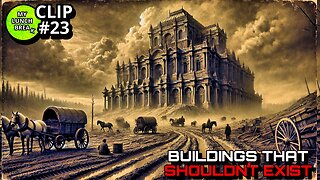 LIVE
LIVE
MYLUNCHBREAK CHANNEL PAGE
2 hours agoBuildings That Shouldn't Exist?
698 watching -
 42:09
42:09
BonginoReport
3 hours agoLock Her Up (Ep.107) - 12/18/2024
50.4K86 -
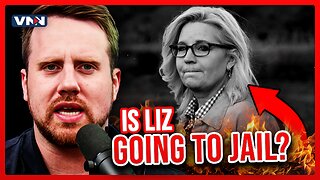 LIVE
LIVE
Vigilant News Network
15 hours agoLiz Cheney’s Problems Just Got WORSE | The Daily Dose
1,226 watching -
 22:04
22:04
Scammer Payback
17 hours agoTorturing a Scammer Till They Give Up
4.16K9


